Winter in Oklahoma transforms the landscape into a serene, chilly wonderland, offering a unique opportunity to observe an array of bird species that either call this region home year-round or visit as part of their migratory journey.
During this season, the state becomes a haven for birdwatchers and nature enthusiasts alike. From the vibrant plumage of cardinals to the melodious songs of sparrows, the diversity of avian life is remarkable.
Each species, with its distinct behaviors and adaptations, adds a special touch to the winter environment.
The list of 47 winter birds that adorn the skies and landscapes of Oklahoma, provides a splendid spectacle of nature’s resilience and beauty in the colder months.
47 Winter Birds In Oklahoma
Winter in Oklahoma sees a variety of bird species, either residing year-round or visiting during their migratory paths. Here’s a list of 47 winter birds you might encounter in Oklahoma:
1. House Sparrow (Passer domesticus)
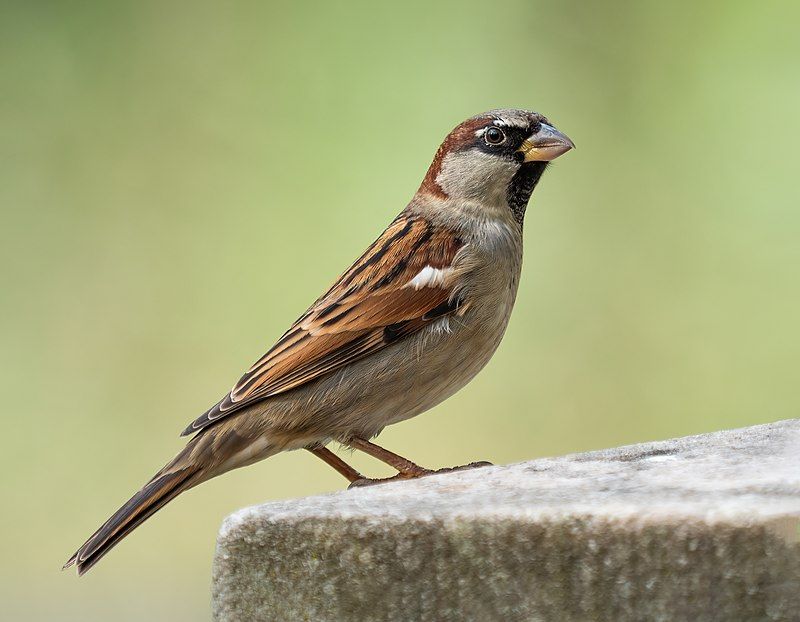
The House Sparrow, introduced from Europe, is now one of the most common birds in urban areas worldwide.
These small, robust birds have a distinctive appearance: males feature gray crowns, white cheeks, a black bib, and rufous neck, while females and juveniles are duller, with brown and gray plumage.
They are highly adaptable and often seen in groups, feeding on seeds, insects, and human-provided food. House Sparrows are known for their lively, chirping song and are often found near buildings, parks, and gardens.
| Kingdom | Animalia |
| Phylum | Chordata |
| Clade | Dinosauria |
| Class | Aves |
| Order | Passeriformes |
| Family | Passeridae |
| Genus | Passer |
| Species | P. domesticus |
2. American Goldfinch (Spinus tristis)

The American Goldfinch is a small, vibrant bird known for the male’s bright yellow plumage during the breeding season. Females and non-breeding males have a more subdued olive-yellow color.
These birds are primarily seed eaters, with a fondness for thistle, and are often seen at bird feeders.
American Goldfinches are social, frequently forming flocks, and are known for their undulating flight pattern and sweet, twittering song. They inhabit open areas like meadows, gardens, and orchards.
| Kingdom | Animalia |
| Phylum | Chordata |
| Clade | Dinosauria |
| Class | Aves |
| Order | Passeriformes |
| Family | Fringillidae |
| Genus | Spinus |
| Species | S. tristis |
3. Northern Cardinal (Cardinalis cardinalis)
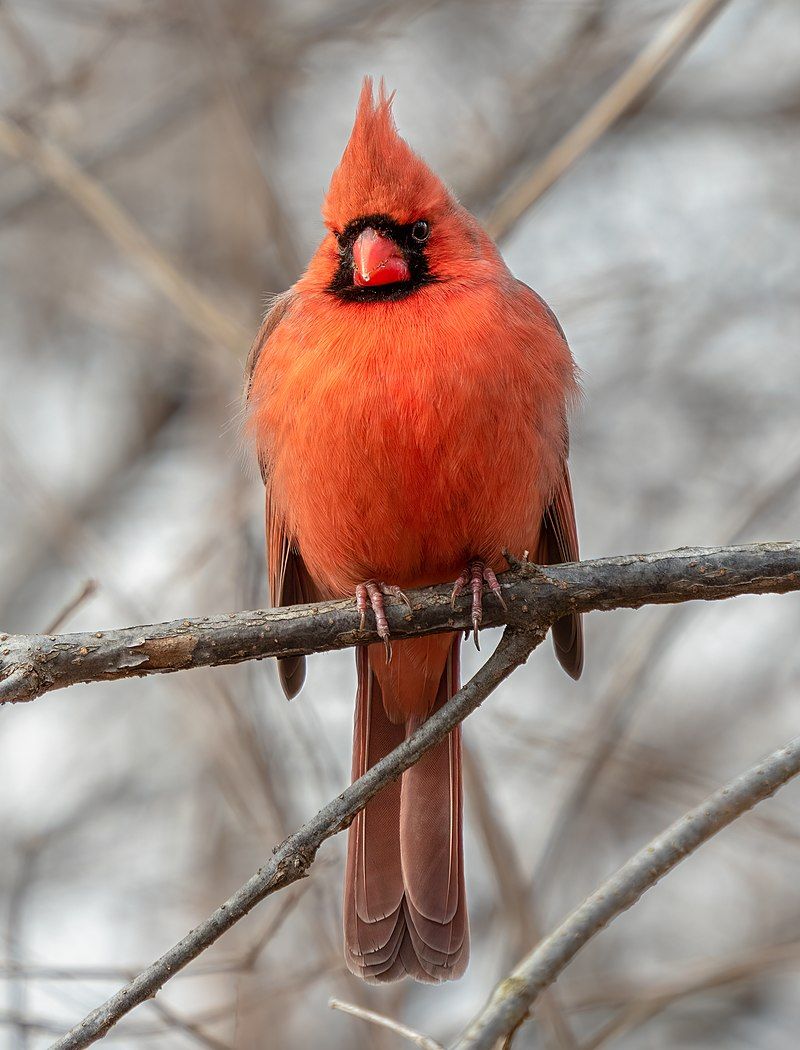
The Northern Cardinal is a beloved bird, with males sporting brilliant red plumage and a distinctive crest, and females exhibiting a more subdued reddish-brown color. Both genders have a black mask on their faces.
These medium-sized birds are year-round residents in their range, inhabiting woodlands, gardens, and shrublands. Cardinals are known for their clear, melodious songs and variety of calls.
They feed on seeds, fruits, and insects and are a common and welcome sight at bird feeders.
| Kingdom | Animalia |
| Phylum | Chordata |
| Clade | Dinosauria |
| Class | Aves |
| Order | Passeriformes |
| Family | Cardinalidae |
| Genus | Cardinalis |
| Species | C. cardinalis |
4. Cardinalidae (Cardinal family)
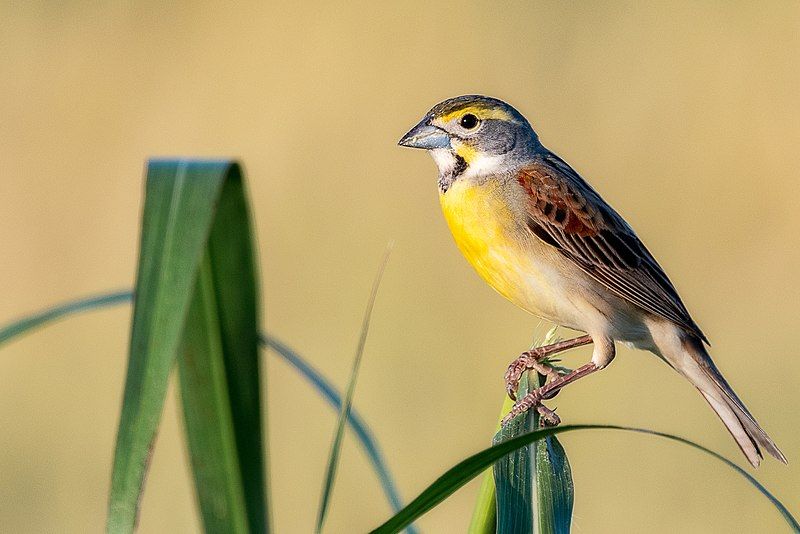
The Cardinalidae family includes cardinals, grosbeaks, and buntings, among others. These birds are known for their stout bills, adapted for seed-eating, and often vibrant plumage.
Members of this family are found across the Americas and are renowned for their melodious songs.
Many species in this family, like the Northern Cardinal and Scarlet Tanager, are popular among birdwatchers due to their striking colors and distinctive calls.
| Kingdom | Animalia |
| Phylum | Chordata |
| Clade | Dinosauria |
| Class | Aves |
| Order | Passeriformes |
| Family | Cardinalidae |
5. Old World Sparrows (Family Passeridae)
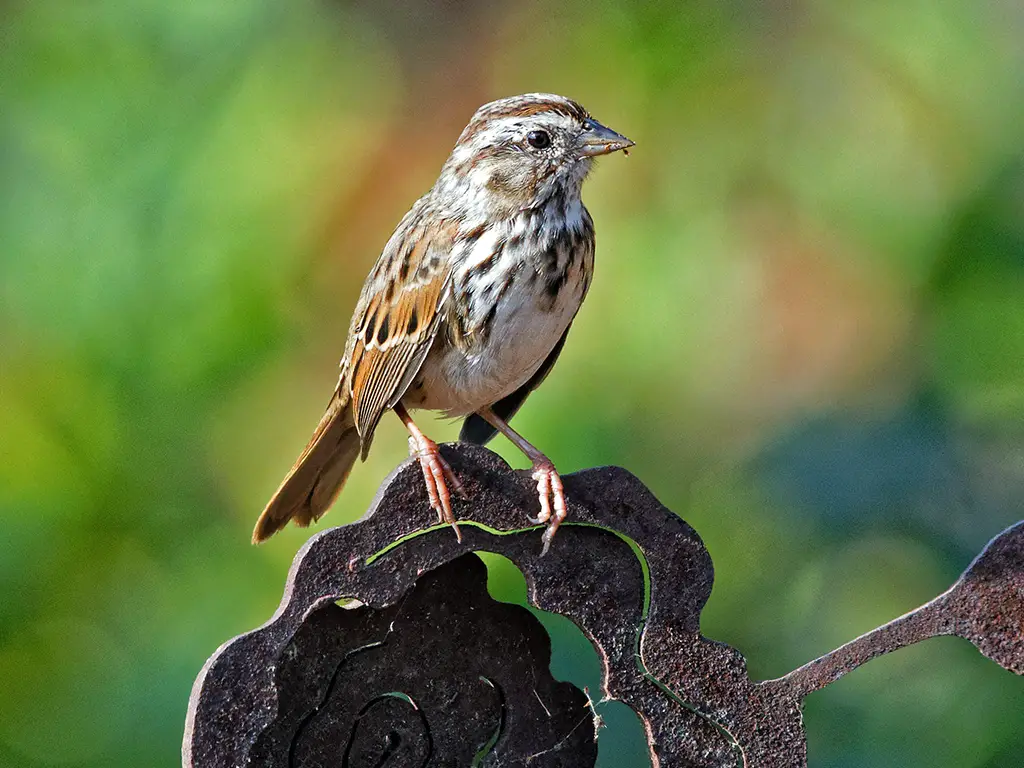
Old World Sparrows, primarily in the family Passeridae, are small, plump birds found in Europe, Asia, and Africa. The most famous member is the House Sparrow.
These birds have adapted well to urban environments and are closely associated with human habitation. They generally have dull but practical plumage, suited for their often urban or agricultural habitats.
Old World Sparrows feed primarily on seeds but will also consume small insects. Their social nature and adaptability have been key to their success in various environments.
| Kingdom | Animalia |
| Phylum | Chordata |
| Clade | Dinosauria |
| Class | Aves |
| Order | Passeriformes |
| Family | Passeridae |
6. Dark-Eyed Junco (Junco hyemalis)
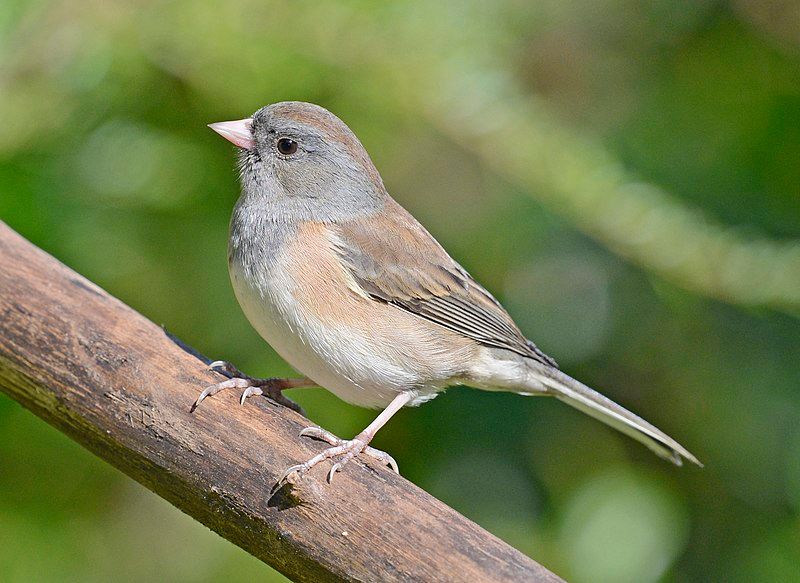
The Dark-Eyed Junco, often referred to as a “snowbird,” is a small, charming bird recognizable by its slate-gray or black head and back, with a white belly.
This coloration varies geographically, resulting in several distinct forms. Juncos are ground feeders, often spotted hopping around under bird feeders or in brushy areas, foraging for seeds and insects.
They are commonly seen in flocks during winter months across North America, and their soft, musical trills are a familiar sound in these settings.
| Kingdom | Animalia |
| Phylum | Chordata |
| Clade | Dinosauria |
| Class | Aves |
| Order | Passeriformes |
| Family | Passerellidae |
| Genus | Junco |
| Species | J. hyemalis |
7. American Robin (Turdus migratorius)
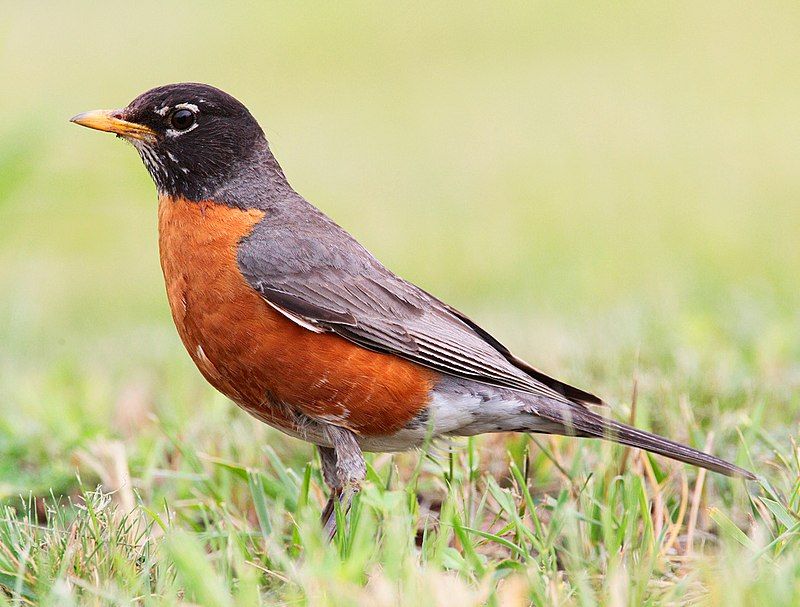
The American Robin is one of the most recognized and widespread backyard birds in North America. Known for their bright orange-red breast, gray back, and cheery song, robins are a sign of spring for many.
They feed on earthworms, insects, and fruit, and can often be seen running and stopping on lawns. Robins are also known for their melodious voices, with a song that is both sweet and powerful.
| Kingdom | Animalia |
| Phylum | Chordata |
| Clade | Dinosauria |
| Class | Aves |
| Order | Passeriformes |
| Family | Turdidae |
| Genus | Turdus |
| Species | T. migratorius |
8. Downy Woodpecker (Dryobates pubescens)
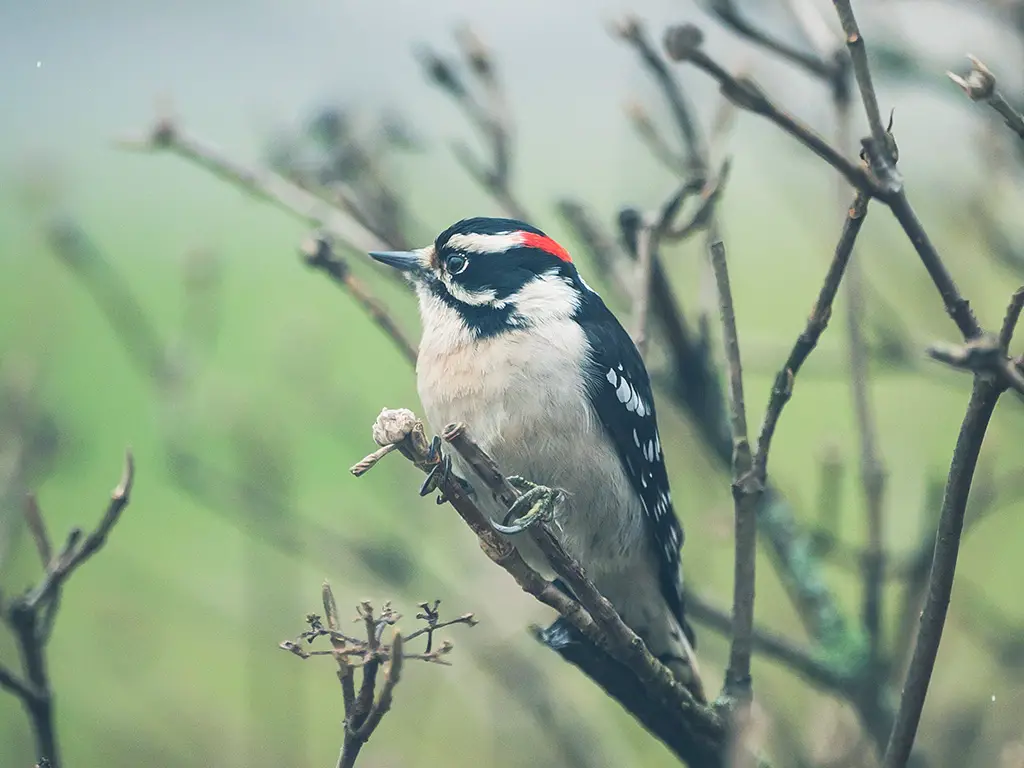
The Downy Woodpecker is the smallest in North America. It has a distinctive black and white plumage, a white back, and a small, pointed bill. Males have a red patch on the back of their heads.
These agile birds are often seen climbing tree trunks and branches in a variety of habitats, including forests and suburban areas, in search of insects. They also visit bird feeders for suet and seeds.
| Kingdom | Animalia |
| Phylum | Chordata |
| Clade | Dinosauria |
| Class | Aves |
| Order | Piciformes |
| Family | Picidae |
| Genus | Dryobates |
| Species | D. pubescens |
9. Red-Bellied Woodpecker (Melanerpes carolinus)
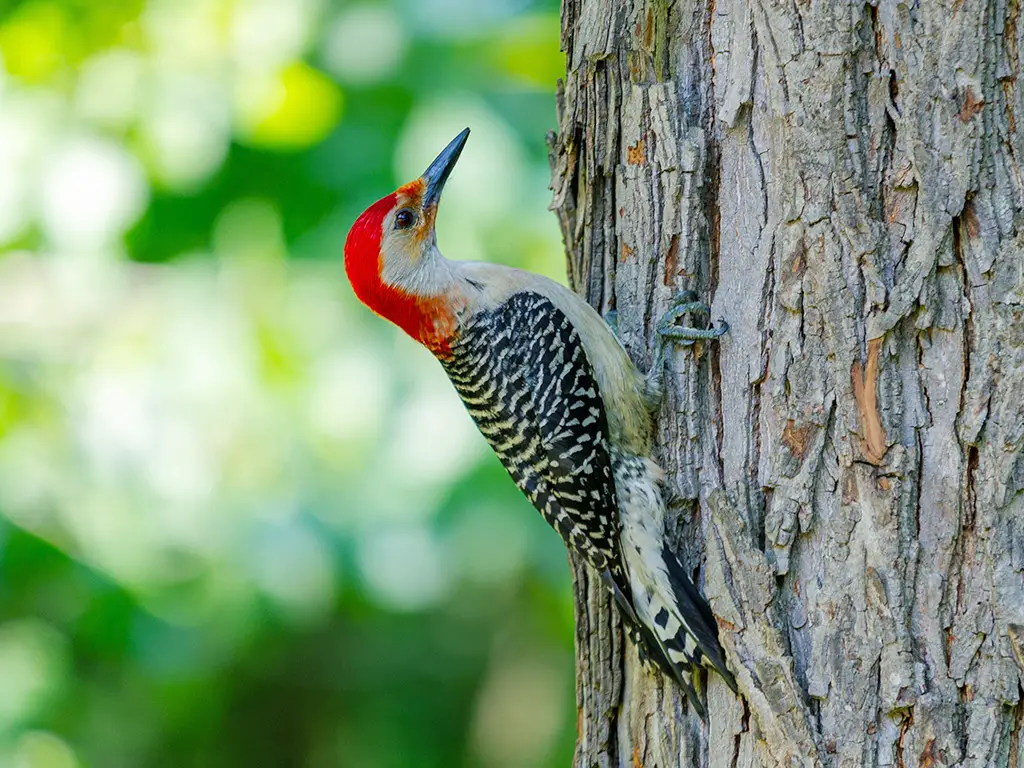
The Red-Bellied Woodpecker is a medium-sized woodpecker with a striking pattern of black and white on its back and wings, and a pale red wash on its belly.
The most prominent feature is the bright red cap and nape found in both sexes, though it is more extensive in males.
These birds are common in woodlands and forests, where they feed on insects, fruits, and nuts. They are also known for their loud calls and are frequent visitors to bird feeders.
| Kingdom | Animalia |
| Phylum | Chordata |
| Clade | Dinosauria |
| Class | Aves |
| Order | Piciformes |
| Family | Picidae |
| Genus | Melanerpes |
| Species | M. carolinus |
10. American Crow (Corvus brachyrhynchos)
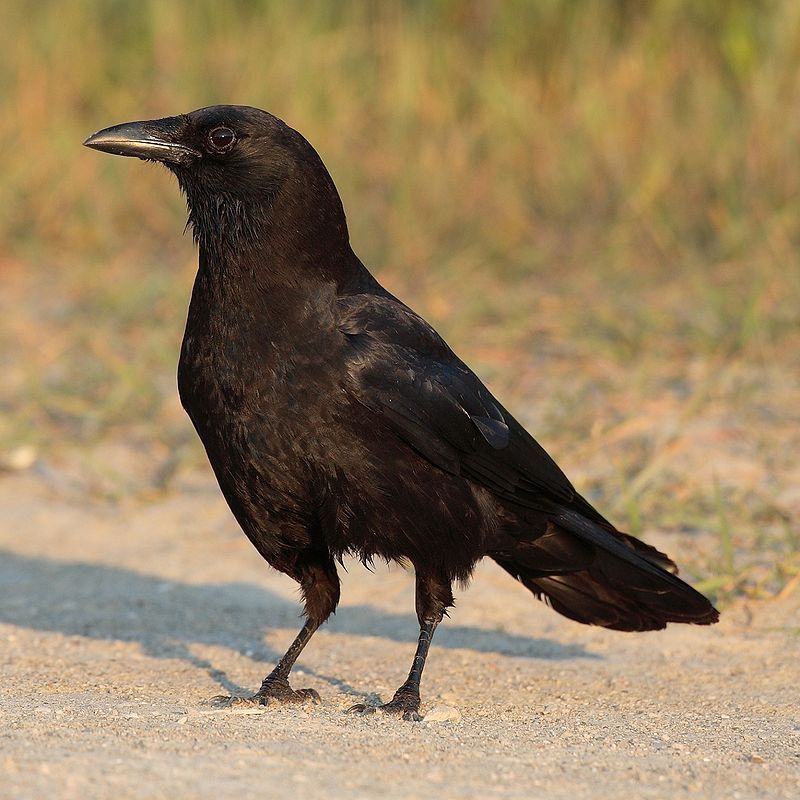
The American Crow is a large, intelligent, all-black bird with a distinctive cawing call. They are highly adaptable and can be found in a wide range of habitats, from rural fields and woodlands to urban areas.
Crows are omnivorous, eating a variety of food, including insects, waste, and small animals. They are known for their problem-solving skills and complex social structures, often seen working in groups to find food or protect their territory.
| Kingdom | Animalia |
| Phylum | Chordata |
| Clade | Dinosauria |
| Class | Aves |
| Order | Passeriformes |
| Family | Corvidae |
| Genus | Corvus |
| Species | C. brachyrhynchos |
11. Carolina Chickadee (Poecile carolinensis)
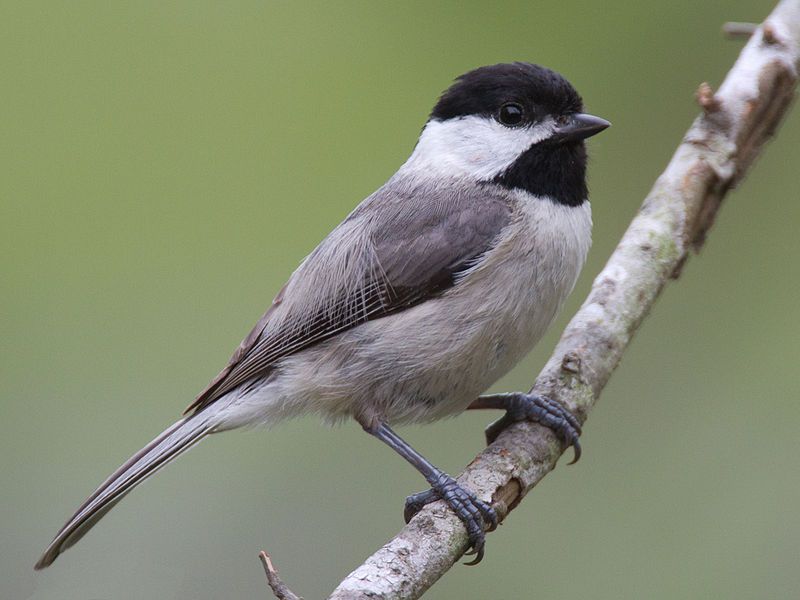
The Carolina Chickadee is a small, charming bird known for its distinctive black, white, and gray plumage. This bird is commonly found in wooded areas across the southeastern United States.
It’s known for its cheerful and complex vocalizations, including a four-part song often described as “fee-bee fee-bay.” Carolina Chickadees are social and curious, often seen flitting about in small groups.
They primarily feed on insects, seeds, and berries. Their adaptability to various habitats, including suburban areas, has made them a favorite among bird watchers.
| Kingdom | Animalia |
| Phylum | Chordata |
| Clade | Dinosauria |
| Class | Aves |
| Order | Passeriformes |
| Family | Paridae |
| Genus | Poecile |
| Species | P. carolinensis |
12. Blue Jay (Cyanocitta cristata)
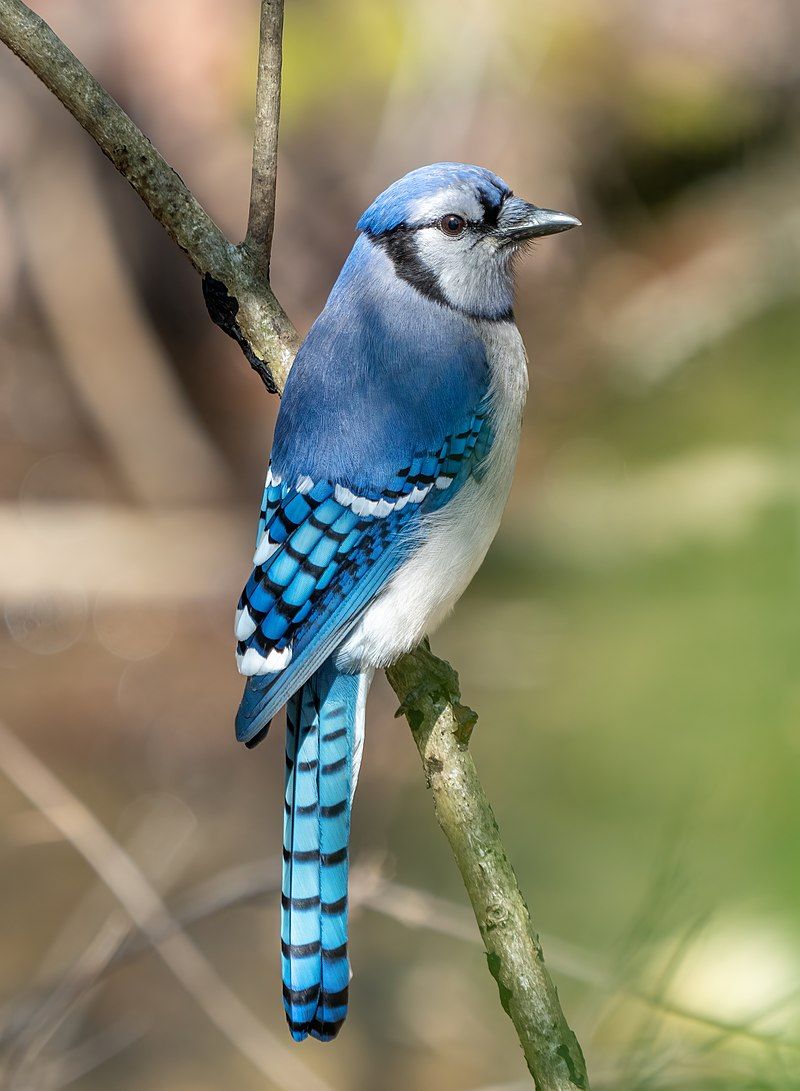
The Blue Jay is a striking bird with bright blue, white, and black plumage. Native to North America, these birds are recognized by their loud calls and bold personalities.
They inhabit forests, parks, and residential areas. Blue Jays are omnivores, eating nuts, seeds, fruits, and occasionally small vertebrates.
They are known for their intelligence and complex social systems, often seen using tools and participating in elaborate social behaviors. Their distinctive crest can be raised or lowered depending on their mood.
| Kingdom | Animalia |
| Phylum | Chordata |
| Clade | Dinosauria |
| Class | Aves |
| Order | Passeriformes |
| Family | Corvidae |
| Genus | Cyanocitta |
| Species | C. cristata |
13. Mourning Dove (Zenaida macroura)
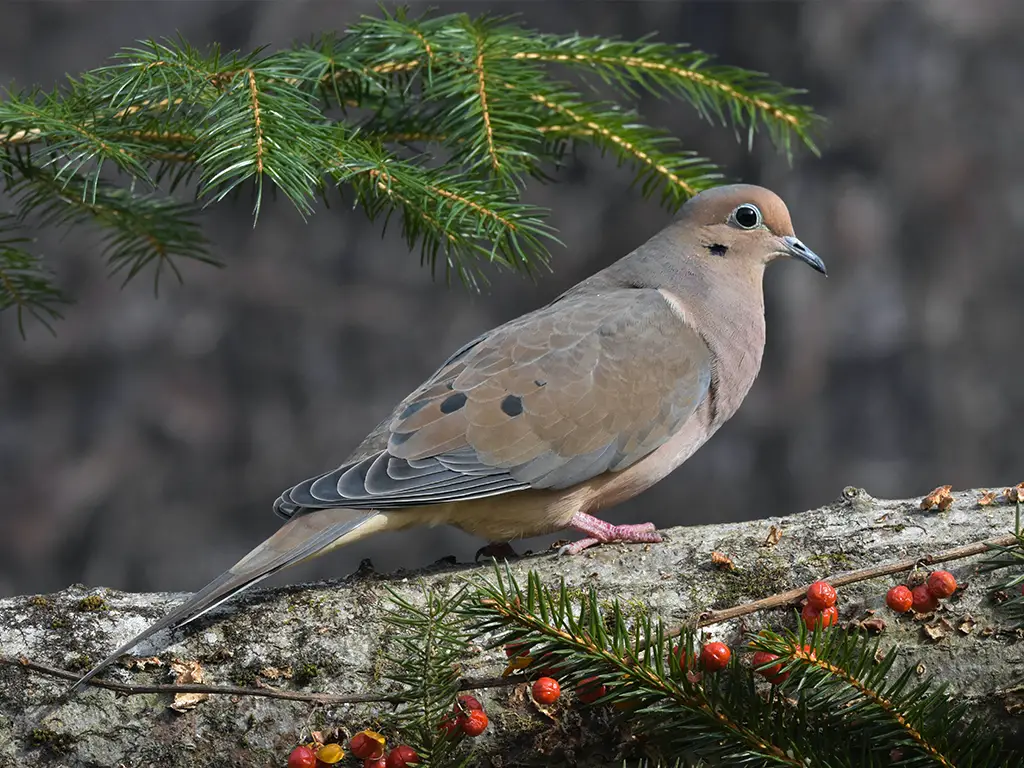
The Mourning Dove is a slender, graceful bird with soft gray-brown feathers and a distinctive, long, pointed tail. Known for its melancholic cooing, the sound is often mistaken for an owl by those unfamiliar with it.
These birds are found across North America in open areas like fields, farms, and urban areas. They feed on seeds, grains, and occasionally insects. Mourning Doves are known for their fast and straight flight, and they are a popular game bird in many regions.
| Kingdom | Animalia |
| Phylum | Chordata |
| Clade | Dinosauria |
| Class | Aves |
| Order | Columbiformes |
| Family | Columbidae |
| Genus | Zenaida |
| Species | Z. macroura |
14. Northern Mockingbird (Mimus polyglottos)
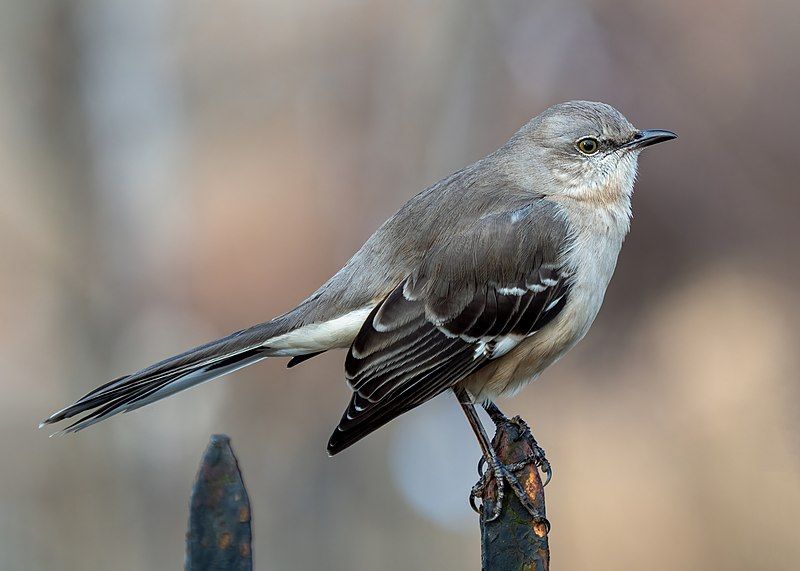
The Northern Mockingbird is renowned for its incredible vocal abilities, capable of mimicking a wide variety of sounds, including other birds, alarms, and machinery.
They have a long tail, gray on the top with a white underside, and white wing patches that are visible in flight.
These birds are commonly found across North America in open and semi-open areas. They are omnivorous, eating insects, fruits, and berries. Northern Mockingbirds are territorial and are often seen aggressively defending their territory against other birds and animals.
| Kingdom | Animalia |
| Phylum | Chordata |
| Clade | Dinosauria |
| Class | Aves |
| Order | Passeriformes |
| Family | Mimidae |
| Genus | Mimus |
| Species | M. polyglottos |
15. Tufted Titmouse (Baeolophus bicolor)
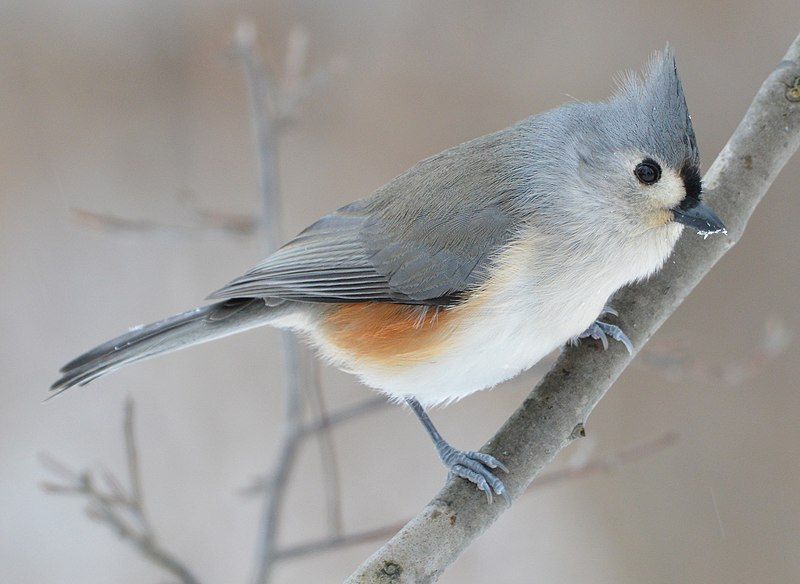
| Kingdom | Animalia |
| Phylum | Chordata |
| Clade | Dinosauria |
| Class | Aves |
| Order | Passeriformes |
| Family | Paridae |
| Genus | Baeolophus |
| Species | B. bicolor |
16. Red-Winged Blackbird (Agelaius phoeniceus)
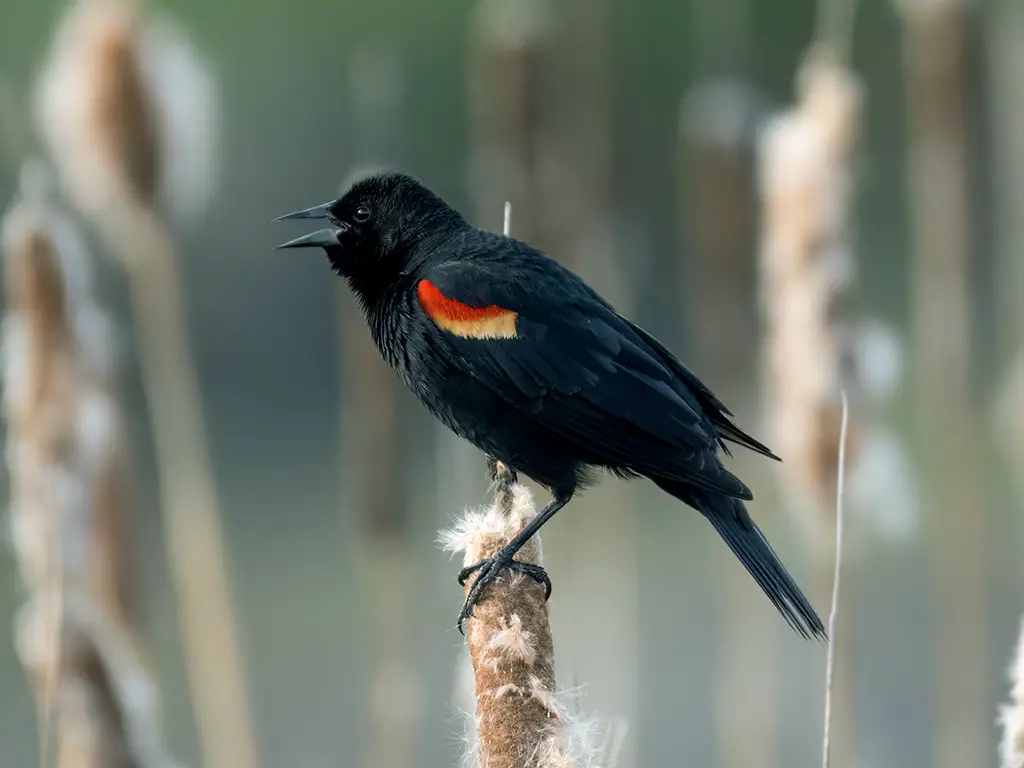
The Red-Winged Blackbird is a striking bird easily identified by the bright red and yellow shoulder patches on males, contrasting with their black body. Females are brown with streaks, often mistaken for sparrows.
Common across North America, these birds are found in wetlands, marshes, and agricultural areas. They have a distinctive, conk-la-ree! song and are known for their aggressive defense of their territory during the breeding season.
Red-Winged Blackbirds are omnivorous, feeding on insects, seeds, and grains. They often gather in large flocks, especially in winter, which can include other blackbird species.
| Kingdom | Animalia |
| Phylum | Chordata |
| Clade | Dinosauria |
| Class | Aves |
| Order | Passeriformes |
| Family | Icteridae |
| Genus | Agelaius |
| Species | A. phoeniceus |
17. House Finch (Haemorhous mexicanus)
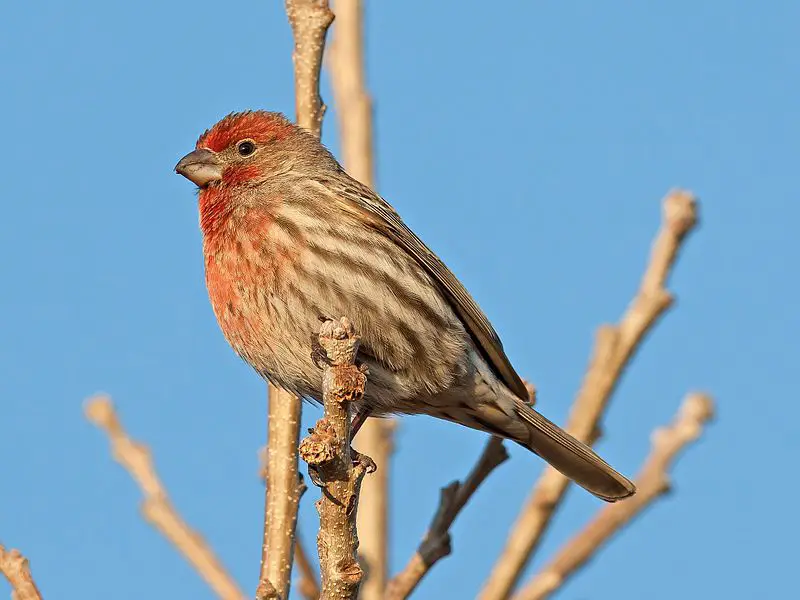
The House Finch is a small, cheerful bird, with males displaying a rosy red face and chest, and brown streaks on the back and belly. Females are brown and streaked overall.
Originally from the western United States, they have been introduced to the eastern states and are now widespread.
House Finches are commonly found in urban and suburban areas, often visiting bird feeders.
heir diet mainly consists of seeds and fruits. Their song is a lively, warbling melody, and they are known for their social behavior, often seen in small flocks.
| Kingdom | Animalia |
| Phylum | Chordata |
| Clade | Dinosauria |
| Class | Aves |
| Order | Passeriformes |
| Family | Fringillidae |
| Genus | Haemorhous |
| Species | H. mexicanus |
18. Mallard (Anas platyrhynchos)
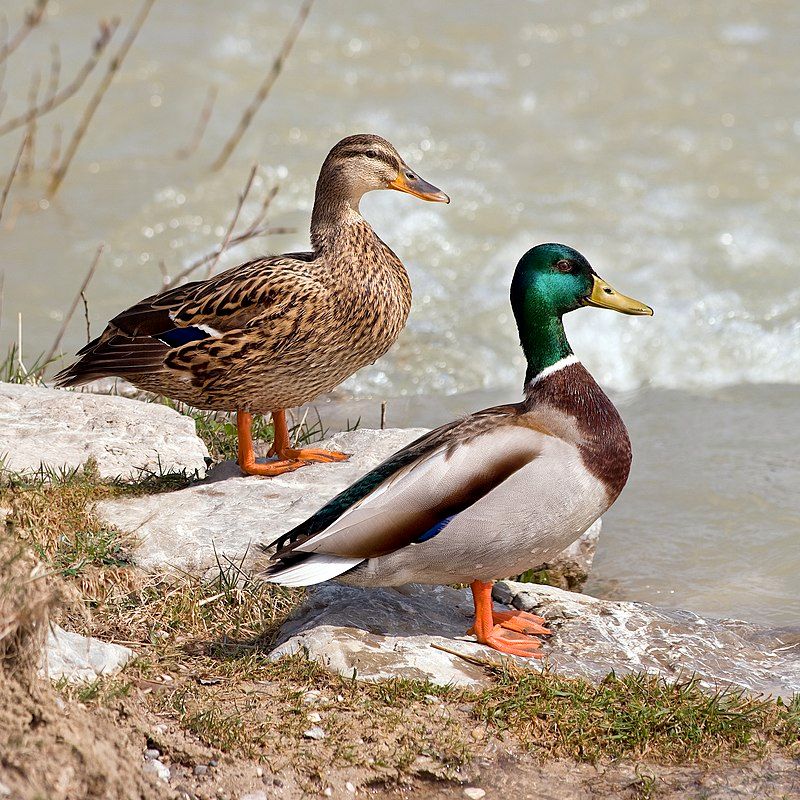
The Mallard is perhaps the most recognizable duck, with the male sporting a glossy green head, white collar, and chestnut-brown chest, while females are mottled brown.
These ducks are found in a variety of freshwater habitats worldwide, including parks, small ponds, and large lakes. Mallards are omnivorous, feeding on aquatic vegetation, insects, and small fish.
They are known for their quintessential “quack” and are the ancestor of most domestic duck breeds. Mallards are migratory in the northern parts of their range but are year-round residents in milder climates.
| Kingdom | Animalia |
| Phylum | Chordata |
| Clade | Dinosauria |
| Class | Aves |
| Order | Anseriformes |
| Family | Anatidae |
| Genus | Anas |
| Species | A. platyrhynchos |
19. Northern Flicker (Colaptes auratus)

The Northern Flicker is a medium-sized woodpecker with a brown body, black spots, a black crescent on the chest, and a distinctive white rump patch visible in flight.
There are two color forms: the yellow-shafted in the east and north, and the red-shafted in the west. They are found across North America in wooded areas, parks, and suburbs.
Unlike other woodpeckers, Northern Flickers often feed on the ground, mainly eating ants and beetles. Their call is a loud “wick-wick-wick,” and they are known for their drumming on trees and metal surfaces.
| Kingdom | Animalia |
| Phylum | Chordata |
| Clade | Dinosauria |
| Class | Aves |
| Order | Piciformes |
| Family | Picidae |
| Genus | Colaptes |
| Species | C. auratus |
20. Common Starling (Sturnus vulgaris)
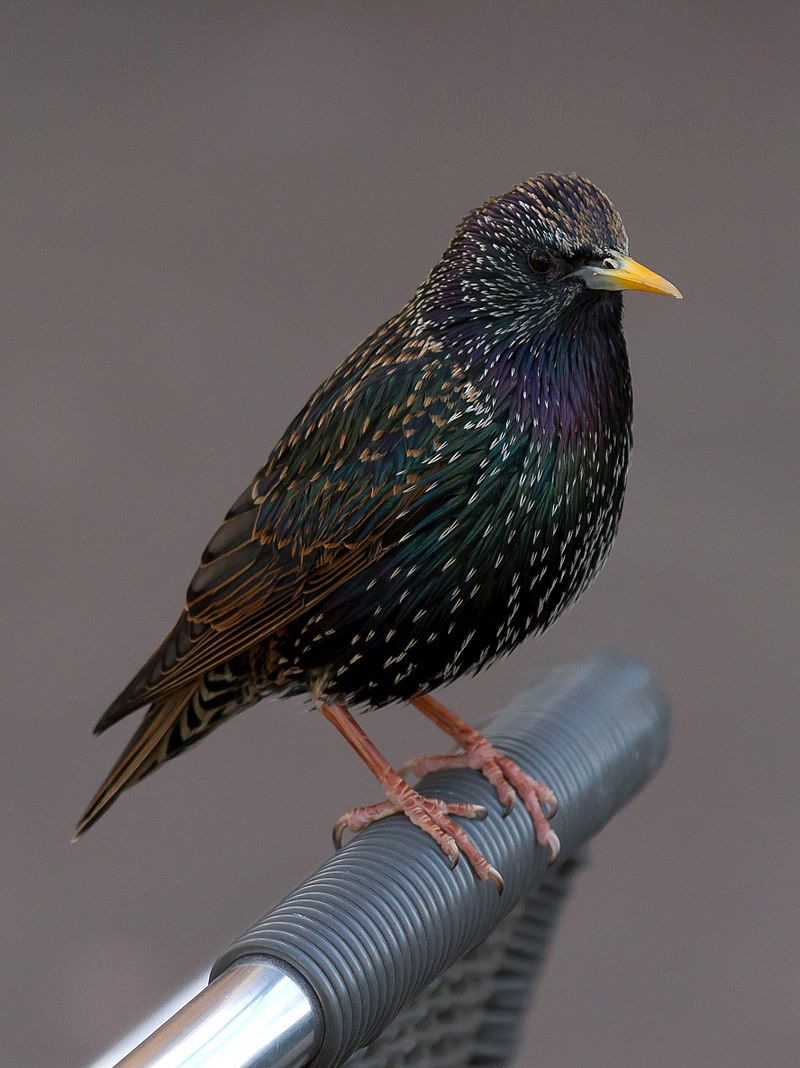
The Common Starling is an invasive species in North America, originally native to Europe. Adults have iridescent black plumage with a sheen of purples and greens, speckled with white spots during the winter.
They are versatile and adaptable, thriving in urban and rural areas. Their diet is diverse, including insects, fruits, and human-provided scraps.
Starlings are known for their incredible murmurations, where thousands of birds fly in coordinated patterns. They have a wide range of vocalizations and are capable of mimicking sounds.
Despite their beauty, they are often considered pests due to their aggressive behavior towards native bird species.
| Kingdom | Animalia |
| Phylum | Chordata |
| Clade | Dinosauria |
| Class | Aves |
| Order | Passeriformes |
| Family | Sturnidae |
| Genus | Sturnus |
| Species | S. vulgaris |
21. Carolina Wren (Thryothorus ludovicianus)
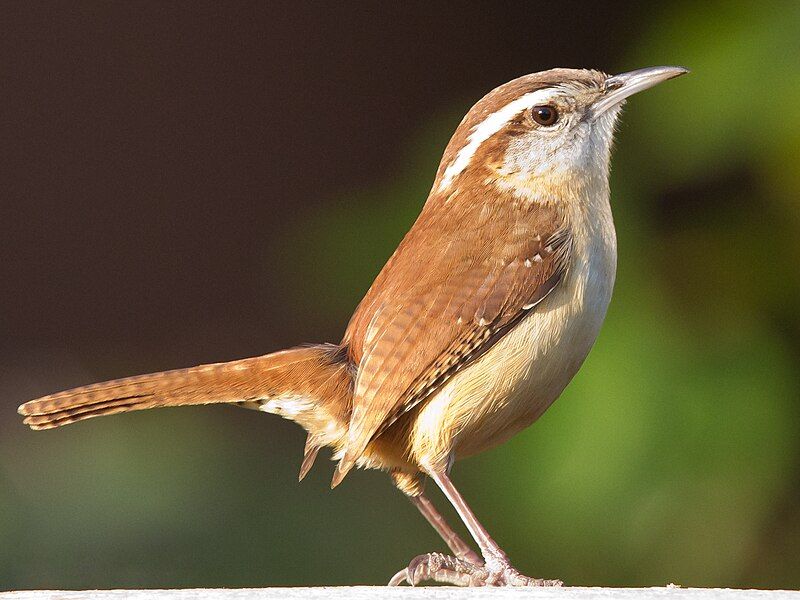
The Carolina Wren is a small, robust bird known for its loud and cheerful song. They have a rich brown upper body, buffy-orange underparts, and a distinctive white eyebrow stripe.
Found primarily in the southeastern United States, these birds are adaptable to various habitats, including suburban gardens and forests.
Carolina Wrens are curious and energetic, often seen hopping around in search of insects and spiders, which make up most of their diet.
Their song is loud and melodic, often heard as a repeated “teakettle-teakettle-teakettle.” They are known for their habit of nesting in a variety of unusual locations, including mailboxes and flower pots.
| Kingdom | Animalia |
| Phylum | Chordata |
| Clade | Dinosauria |
| Class | Aves |
| Order | Passeriformes |
| Family | Troglodytidae |
| Genus | Thryothorus |
| Species | T. ludovicianus |
22. Eastern Bluebird (Sialia sialis)
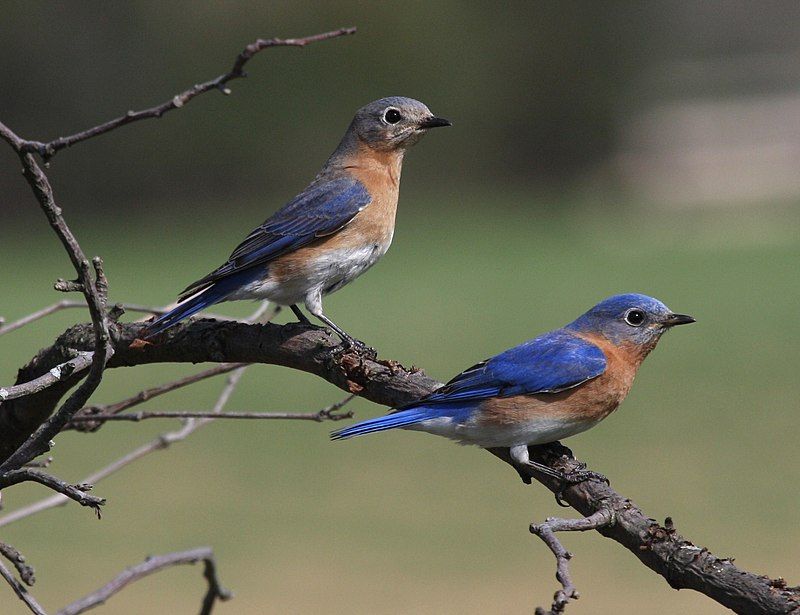
The Eastern Bluebird is a small thrush with a bright blue back, wings, and tail, and a rusty red chest. Females are more subdued in color with grayish tones.
These birds are found in open woodlands, fields, and orchards across eastern North America. They feed on insects and fruits, often seen perching on wires or posts looking for food.
Eastern Bluebirds are known for their sweet, melodious song. They are cavity nesters and have benefited from nest box programs, which have helped their populations recover from declines in the past century.
| Kingdom | Animalia |
| Phylum | Chordata |
| Clade | Dinosauria |
| Class | Aves |
| Order | Passeriformes |
| Family | Turdidae |
| Genus | Sialia |
| Species | S. sialis |
23. Red-Tailed Hawk (Buteo jamaicensis)
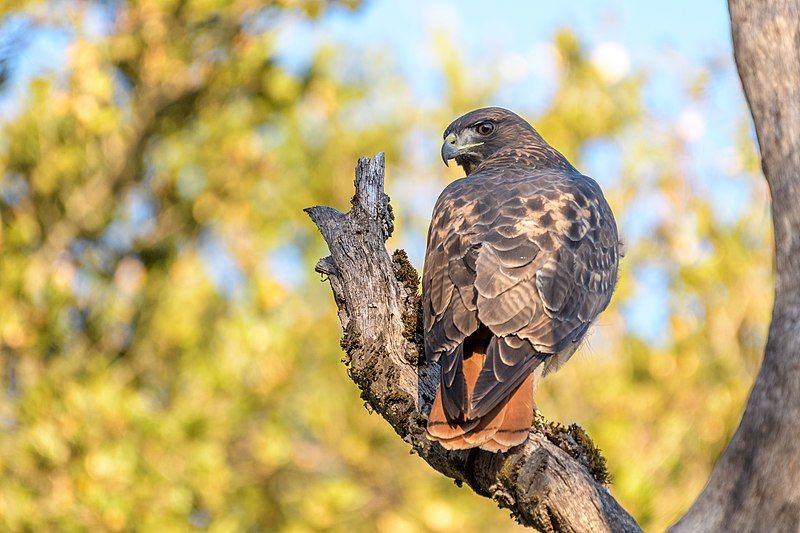
The Red-Tailed Hawk is a large raptor known for its distinctive red tail, most visible in adults. These hawks have a broad, rounded wingspan and are common throughout North America.
They inhabit a wide range of environments, from deserts to forests and urban areas. Red-tailed hawks are known for their soaring flight and keen eyesight, used to spot prey such as rodents, rabbits, and birds.
Their piercing cry is often used in movies as a generic bird of prey sound. They play a vital role in the ecosystem as top predators, helping control rodent populations.
| Kingdom | Animalia |
| Phylum | Chordata |
| Clade | Dinosauria |
| Class | Aves |
| Order | Accipitriformes |
| Family | Accipitridae |
| Genus | Buteo |
| Species | B. jamaicensis |
24. Great Blue Heron (Ardea herodias)
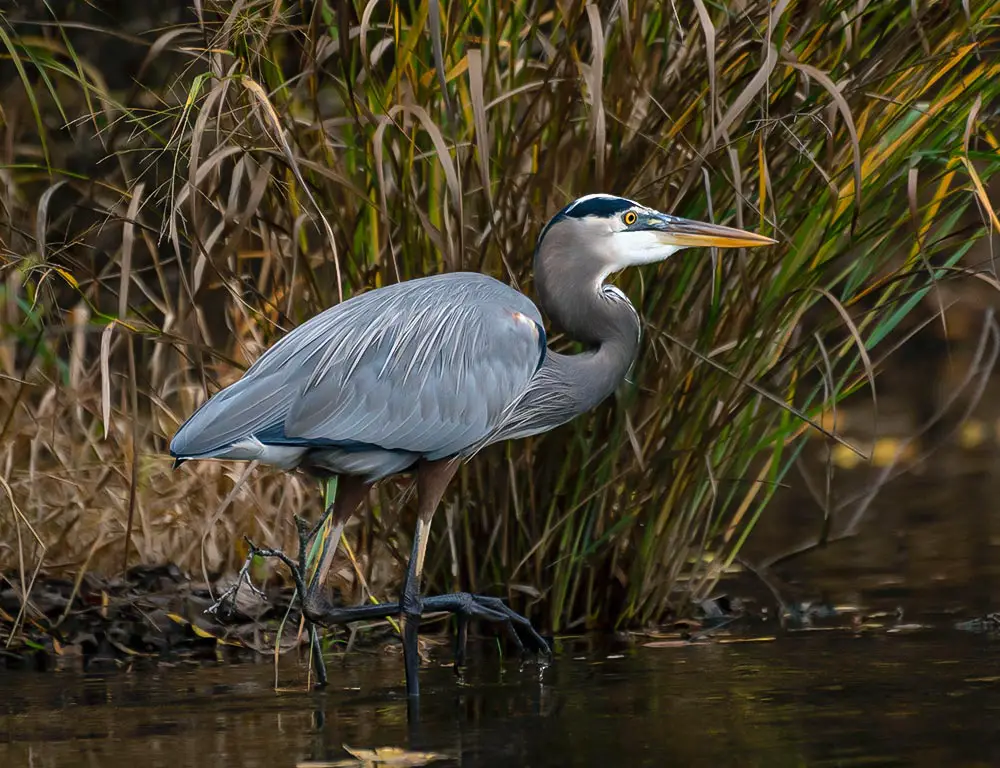
The Great Blue Heron is a large wading bird, notable for its long legs, neck, and sharp beak. They have a blue-gray body, with a black stripe over the eye extending to head plumes.
Found near waters across North and Central America, these herons feed on fish, amphibians, and small mammals, which they catch with sudden lunges.
Great Blue Herons are solitary at most times but come together in colonies to breed. They are known for their slow, majestic flight, with their neck curled into an “S” shape.
| Kingdom | Animalia |
| Phylum | Chordata |
| Clade | Dinosauria |
| Class | Aves |
| Order | Pelecaniformes |
| Family | Ardeidae |
| Genus | Ardea |
| Species | A. herodias |
25. Ring-Billed Gull (Larus delawarensis)
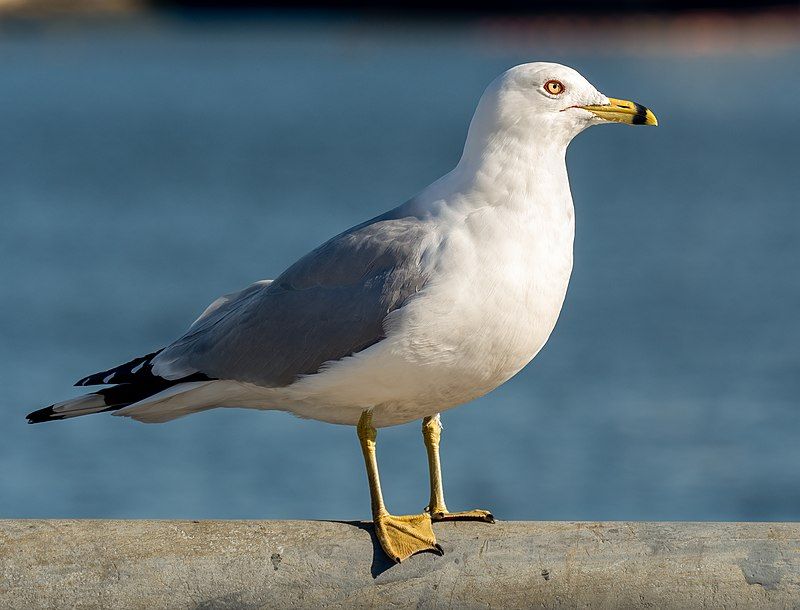
| Kingdom | Animalia |
| Phylum | Chordata |
| Clade | Dinosauria |
| Class | Aves |
| Order | Charadriiformes |
| Family | Laridae |
| Genus | Larus |
| Species | L. delawarensis |
26. Canada Goose (Branta canadensis)
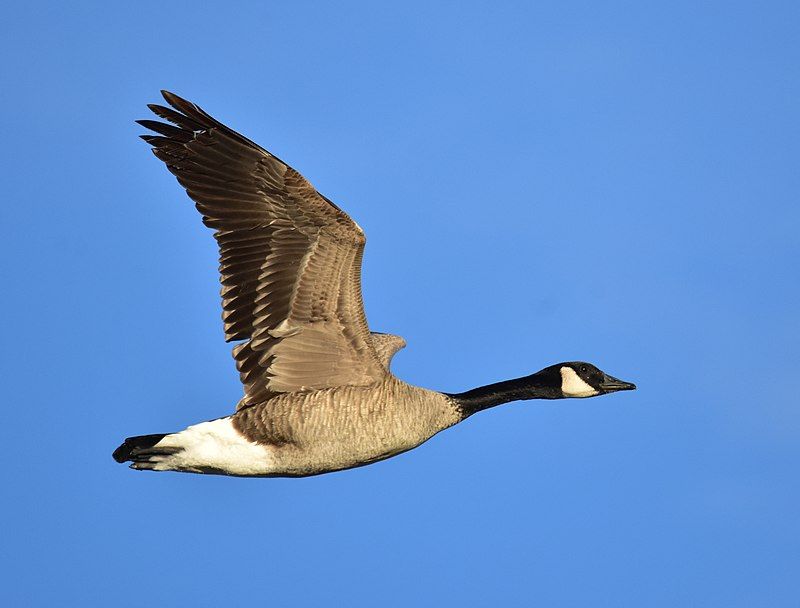
The Canada Goose is a large waterfowl known for its black head and neck, white cheeks, and brown body. These geese are native to North America and are easily recognized by their honking call.
They are found near lakes, rivers, and in green urban areas. Canada Geese are primarily herbivores, feeding on grasses, grains, and aquatic plants.
They are famous for their V-shaped flight formation during migration. These geese are highly social and known for their aggressive behavior, especially when protecting their nests.
Their adaptability to various habitats has led to their widespread presence across North America and in parts of Europe.
| Kingdom | Animalia |
| Phylum | Chordata |
| Clade | Dinosauria |
| Class | Aves |
| Order | Anseriformes |
| Family | Anatidae |
| Genus | Branta |
| Species | B. canadensis |
27. Harris’s Sparrow (Zonotrichia querula)
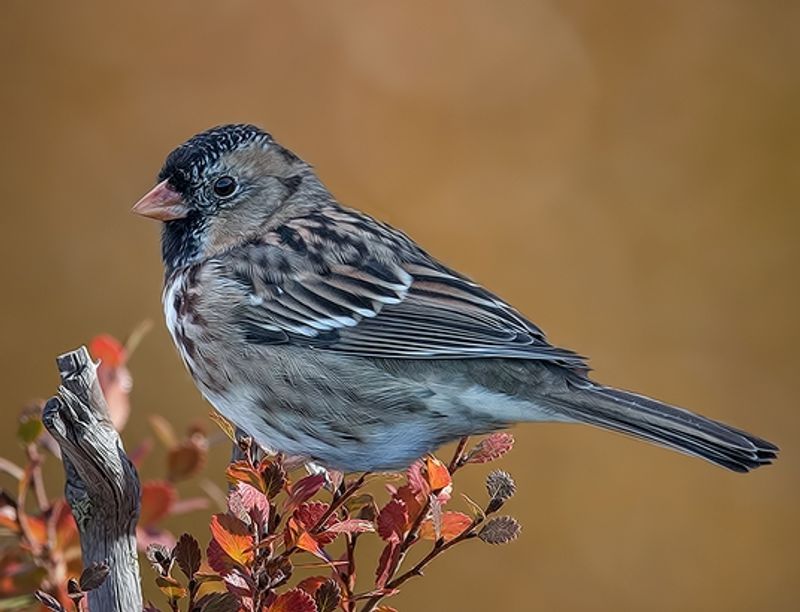
Harris’s Sparrow is the largest of the North American sparrows and is notable for its striking black bib, pink bill, and brown-streaked plumage.
Found mainly in the central parts of North America, they breed in Canada and migrate to the central United States in winter. These birds inhabit brushy areas and woodlands.
Their diet mainly consists of seeds and insects. Harris’s Sparrows are known for their beautiful song, which is a series of clear whistles. They are somewhat shy and elusive, often seen foraging on the ground in small flocks.
| Kingdom | Animalia |
| Phylum | Chordata |
| Clade | Dinosauria |
| Class | Aves |
| Order | Passeriformes |
| Family | Passerellidae |
| Genus | Zonotrichia |
| Species | Z. querula |
28. Common Grackle (Quiscalus quiscula)
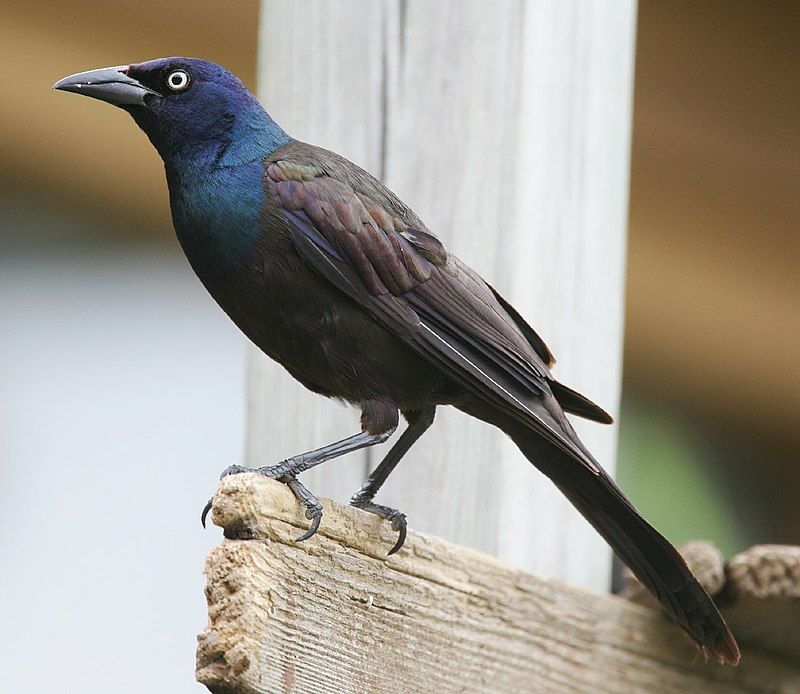
The Common Grackle is a medium-sized blackbird with a long tail and a glossy iridescent body. Males are larger and more iridescent than females.
These birds are found across much of North America, in fields, parks, and wetlands. Grackles are omnivorous, eating a wide variety of foods including insects, grains, and small animals.
They are known for their loud and harsh calls. Common Grackles are social birds, often seen in large flocks, especially near roosts. They are adaptable and have thrived in human-altered landscapes.
| Kingdom | Animalia |
| Phylum | Chordata |
| Clade | Dinosauria |
| Class | Aves |
| Order | Passeriformes |
| Family | Icteridae |
| Genus | Quiscalus |
| Species | Q. quiscula |
29. Eurasian Collared Dove (Streptopelia decaocto)
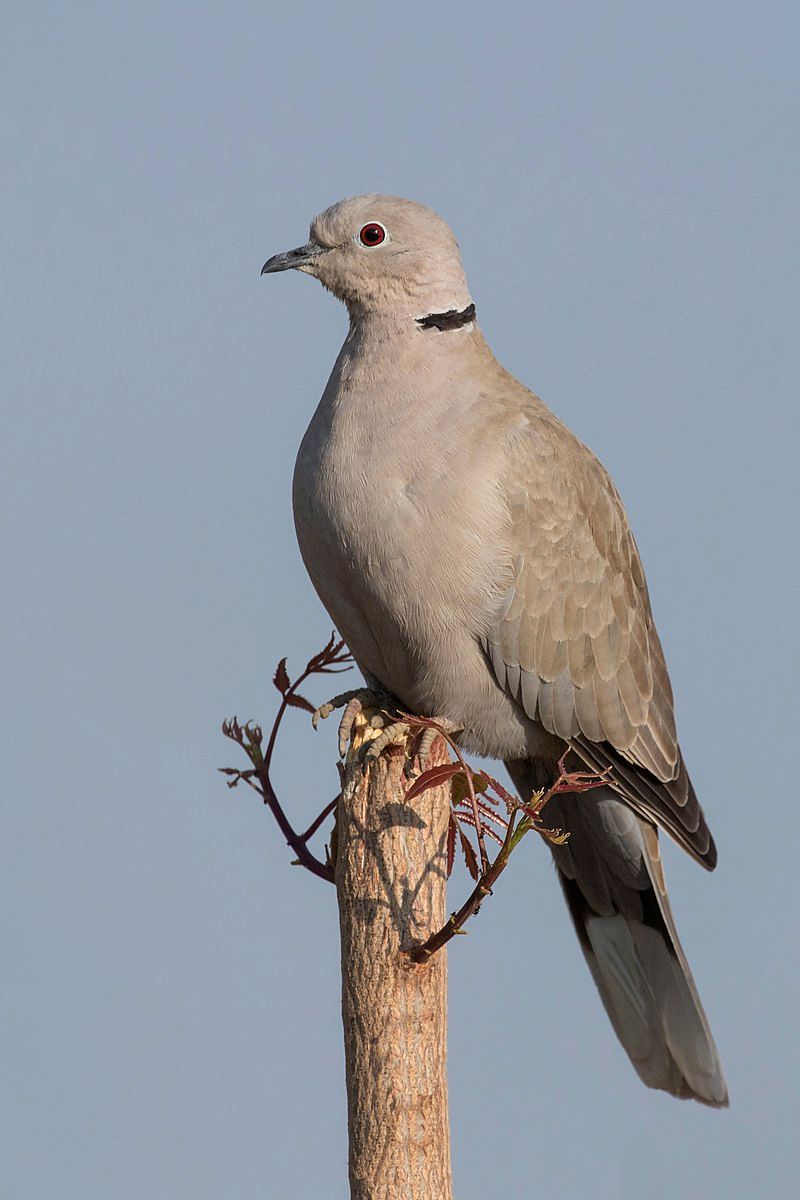
The Eurasian Collared Dove is a medium-sized dove with a slender body, characterized by its pale gray color and distinctive black collar on the back of its neck. Originally from Asia and Europe, these birds have expanded their range into North America.
They are commonly found in urban and suburban areas, where they feed on seeds and grains. Their call is a distinctive three-part cooing, often described as a “coo-COO-coo.” Eurasian Collared Doves are known for their ability to breed rapidly and are often seen in pairs or small flocks.
| Kingdom | Animalia |
| Phylum | Chordata |
| Clade | Dinosauria |
| Class | Aves |
| Order | Columbiformes |
| Family | Columbidae |
| Genus | Streptopelia |
| Species | S. decaocto |
30. Purple Finch (Haemorhous purpureus)
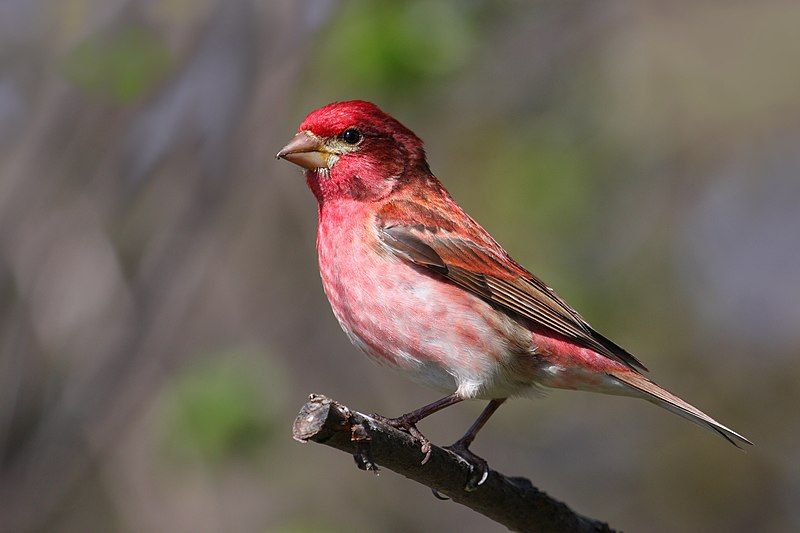
| Kingdom | Animalia |
| Phylum | Chordata |
| Clade | Dinosauria |
| Class | Aves |
| Order | Passeriformes |
| Family | Fringillidae |
| Genus | Haemorhous |
| Species | H. purpureus |
31. American Kestrel (Falco sparverius)
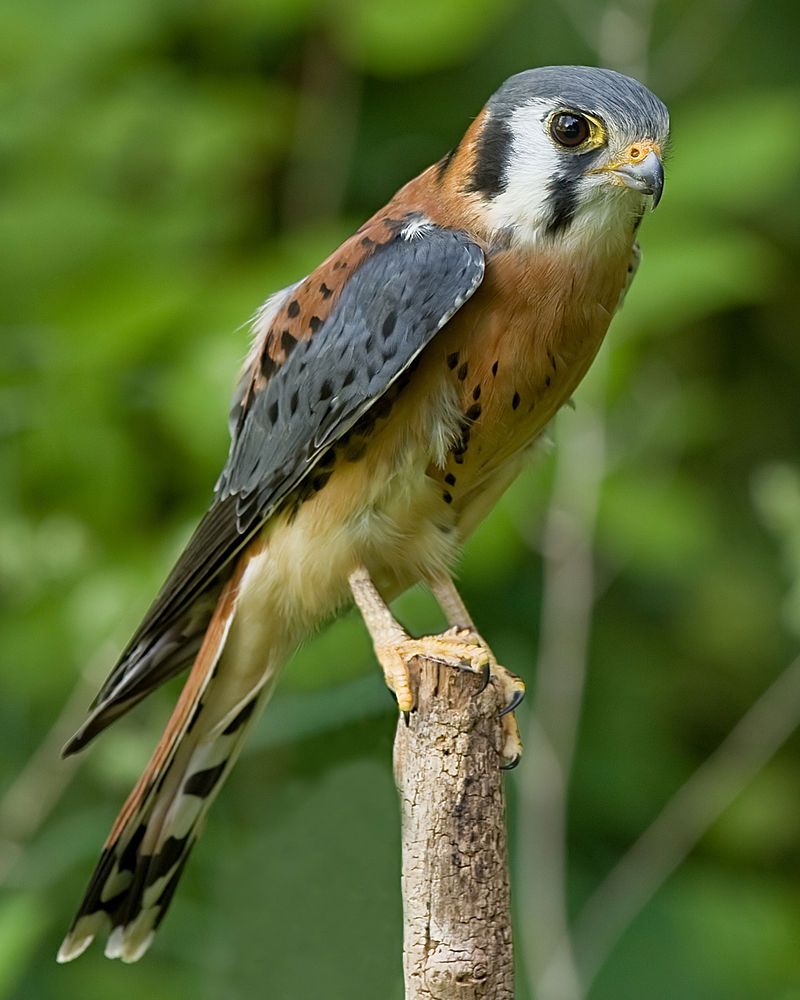
The American Kestrel, North America’s smallest falcon, is known for its strikingly colorful plumage. Males have slate-blue wings and a rusty-red back and tail, while females have a brown barred pattern.
They are found across the Americas in various habitats, including open fields, urban areas, and deserts. Kestrels feed primarily on insects, small mammals, and birds, catching their prey in a swift dive.
They are known for their ability to hover in the air with rapid wingbeats. American Kestrels are cavity nesters, often using old woodpecker holes. Their distinctive call is a series of sharp, high-pitched klee! or killy! sounds.
| Kingdom | Animalia |
| Phylum | Chordata |
| Clade | Dinosauria |
| Class | Aves |
| Order | Falconiformes |
| Family | Falconidae |
| Genus | Falco |
| Species | F. sparverius |
32. American Tree Sparrow (Spizelloides arborea)
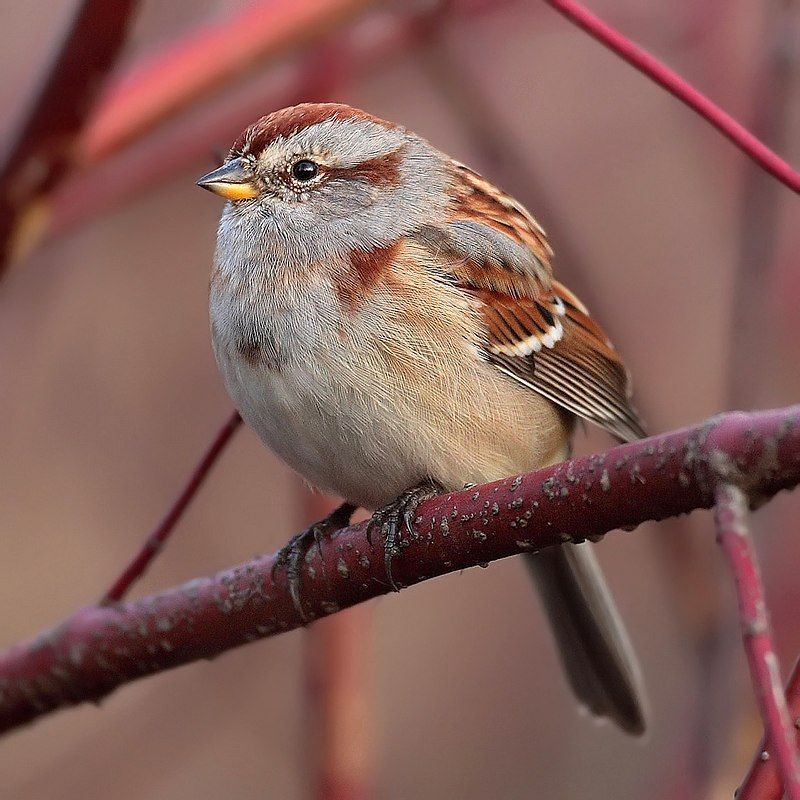
The American Tree Sparrow is a small, plump bird with a rusty cap and eye line, a gray face, and a bi-colored bill. They breed in the Arctic tundra and migrate to the central and eastern United States in winter.
These sparrows are often found in open, scrubby areas, feeding on seeds and insects. They are easily identified by their sweet, musical chirping.
Despite their name, they are more often seen foraging on the ground rather than in trees. The American Tree Sparrow is a hardy bird, braving cold temperatures and snow during the winter months.
| Kingdom | Animalia |
| Phylum | Chordata |
| Clade | Dinosauria |
| Class | Aves |
| Order | Passeriformes |
| Family | Passerellidae |
| Genus | Spizelloides |
| Species | S. arborea |
33. Bewick’s Wren (Thryomanes bewickii)
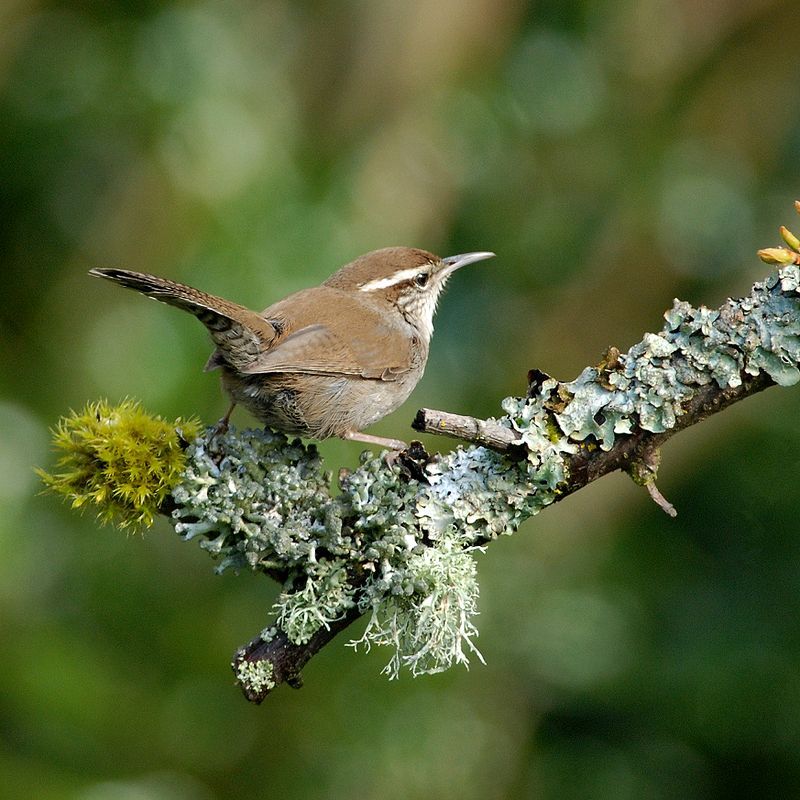
Bewick’s Wren is a small, active bird with a long, white-striped tail often held upright. They have a brown back and grayish underparts.
This bird is native to North America, mainly found in the western and central regions. They inhabit open woodlands, chaparral, and backyard gardens.
Bewick’s Wrens are known for their loud and complex song, a mix of trills and whistles. They are insectivorous, adeptly foraging for bugs in the underbrush.
These wrens are curious and not particularly shy, often venturing close to human habitation.
| Kingdom | Animalia |
| Phylum | Chordata |
| Clade | Dinosauria |
| Class | Aves |
| Order | Passeriformes |
| Family | Troglodytidae |
| Genus | Thryomanes |
| Species | T. bewickii |
34. Pine Siskin (Spinus pinus)
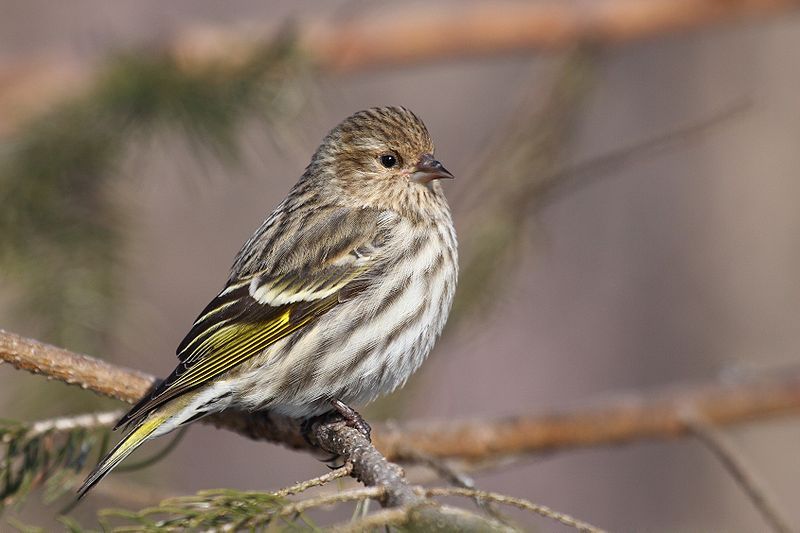
The Pine Siskin is a small, brown-streaked finch with yellow edgings on its wings and tail. They are found in coniferous and mixed forests across North America.
Pine Siskins are highly social birds, often seen in flocks, especially during winter. Their diet mainly consists of seeds, particularly those of conifers, as well as some insects.
They are known for their distinctive, buzzy “zzzzrr” call. Pine Siskins are nomadic, with their movements and wintering locations varying greatly from year to year.
| Kingdom | Animalia |
| Phylum | Chordata |
| Clade | Dinosauria |
| Class | Aves |
| Order | Passeriformes |
| Family | Fringillidae |
| Genus | Spinus |
| Species | S. pinus |
35. Ruby-Throated Hummingbird (Archilochus colubris)
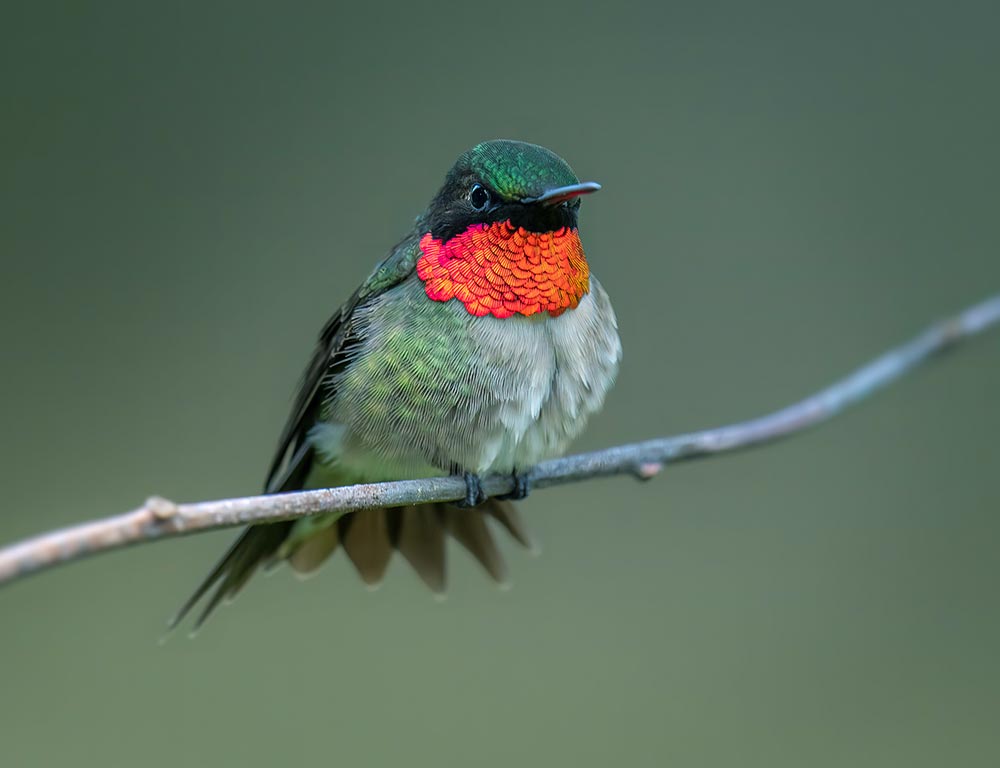
| Kingdom | Animalia |
| Phylum | Chordata |
| Clade | Strisores |
| Class | Aves |
| Order | Apodiformes |
| Family | Trochilidae |
| Genus | Archilochus |
| Species | A. colubris |
36. Pileated Woodpecker (Dryocopus pileatus)
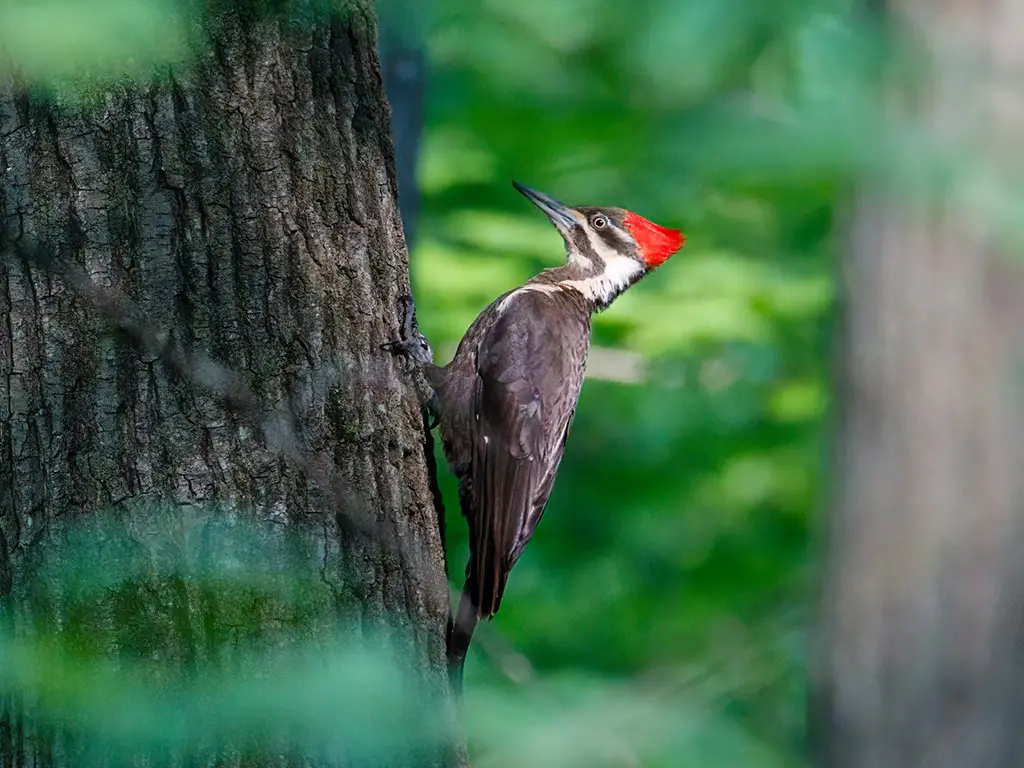
The Pileated Woodpecker is one of the largest woodpecker species in North America, easily identified by its striking black body, white stripes on the face and neck, and a prominent red crest. Males have a red line from the bill to the throat.
These birds are found in mature forests across Canada, the eastern and northwestern United States. Their diet mainly consists of insects, especially carpenter ants and wood-boring beetle larvae, which they forage by drilling large holes in trees.
The Pileated Woodpecker’s call is a loud, wild laugh, and its drumming can be heard from great distances. They are important to their ecosystems, as their excavation activities create habitat for other species.
| Kingdom | Animalia |
| Phylum | Chordata |
| Clade | Dinosauria |
| Class | Aves |
| Order | Piciformes |
| Family | Picidae |
| Genus | Dryocopus |
| Species | D. pileatus |
37. American White Pelican (Pelecanus erythrorhynchos)
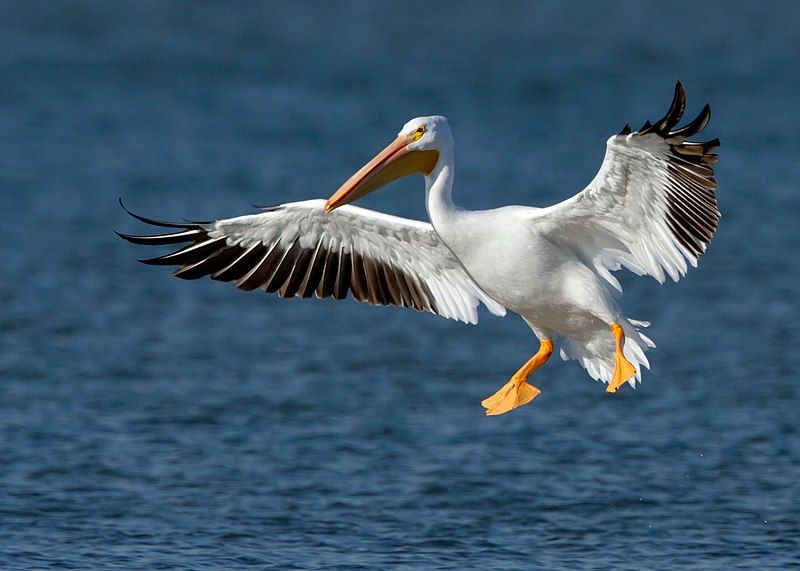
The American White Pelican is a massive water bird with a distinctive white body, black wingtips, and a long, orange bill. One of the largest North American birds, they are often seen gliding gracefully over lakes and rivers.
These pelicans breed in colonies on lakes in central and western North America and migrate to the Gulf Coast and Mexico for winter.
Unlike their brown cousins, they do not dive for their food; instead, they cooperatively herd fish into shallow waters and scoop them up with their large bills.
The American White Pelican is a species of conservation concern in some areas due to habitat loss.
| Kingdom | Animalia |
| Phylum | Chordata |
| Clade | Dinosauria |
| Class | Aves |
| Order | Pelecaniformes |
| Family | Pelecanidae |
| Genus | Pelecanus |
| Species | P. erythrorhynchos |
38. Eastern Phoebe (Sayornis phoebe)
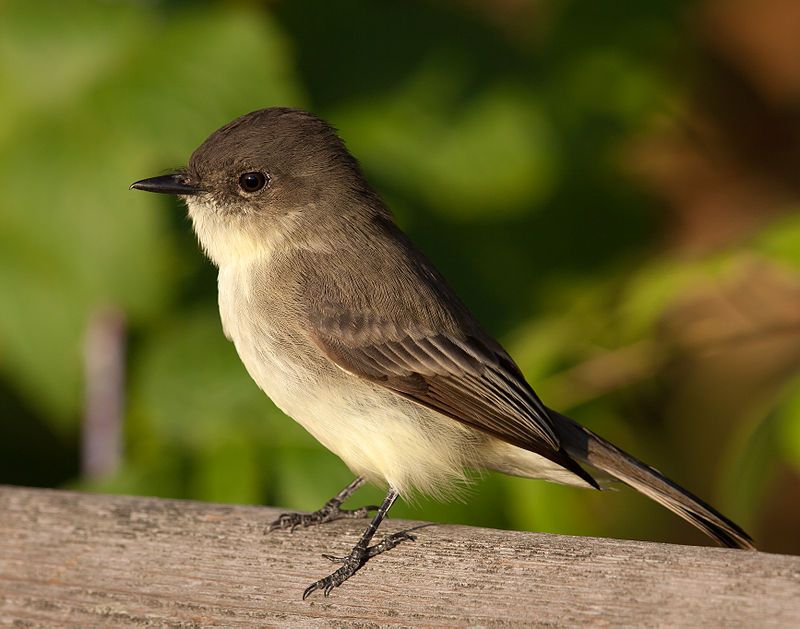
The Eastern Phoebe is a small passerine bird, dull brownish-gray above and paler below. They have a faint white throat and a slightly darker head.
Common across eastern North America, these birds are often found near water in rural and suburban areas.
Eastern Phoebes are among the first migratory birds to return to their breeding grounds in spring. They are flycatchers, feeding mainly on insects caught in mid-air.
These birds are known for their distinct “phoebe” call and their habit of wagging their tail when perched. Eastern Phoebes often build their nests on human structures like bridges and buildings.
| Kingdom | Animalia |
| Phylum | Chordata |
| Clade | Dinosauria |
| Class | Aves |
| Order | Passeriformes |
| Family | Tyrannidae |
| Genus | Sayornis |
| Species | S. phoebe |
39. Barn Swallow (Hirundo rustica)

The Barn Swallow is a small, graceful bird with a deep blue back, wings, and tail, and a rufous to tawny underbelly.
Known for their long, forked tail, they are found throughout North America and are the most widespread species of swallow in the world.
These birds are agile fliers, feeding on insects caught on the wing. Barn Swallows are closely associated with human habitation and frequently build their mud nests on man-made structures.
Their chattering song is a familiar sound in rural areas and open country. The Barn Swallow’s migration is a remarkable journey, traveling long distances between breeding and wintering areas.
| Kingdom | Animalia |
| Phylum | Chordata |
| Clade | Dinosauria |
| Class | Aves |
| Order | Passeriformes |
| Family | Hirundinidae |
| Genus | Hirundo |
| Species | H. rustica |
40. Brown-Headed Cowbird (Molothrus ater)
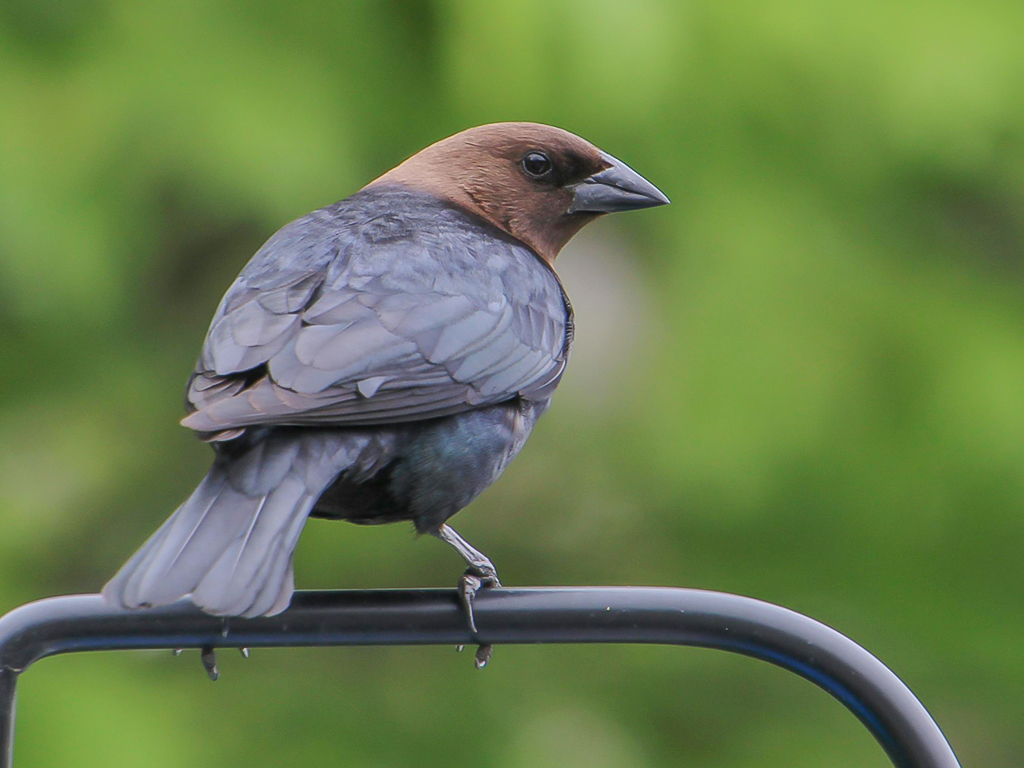
| Kingdom | Animalia |
| Phylum | Chordata |
| Clade | Dinosauria |
| Class | Aves |
| Order | Passeriformes |
| Family | Icteridae |
| Genus | Molothrus |
| Species | M. ater |
41. Broad-Winged Hawk (Buteo platypterus)
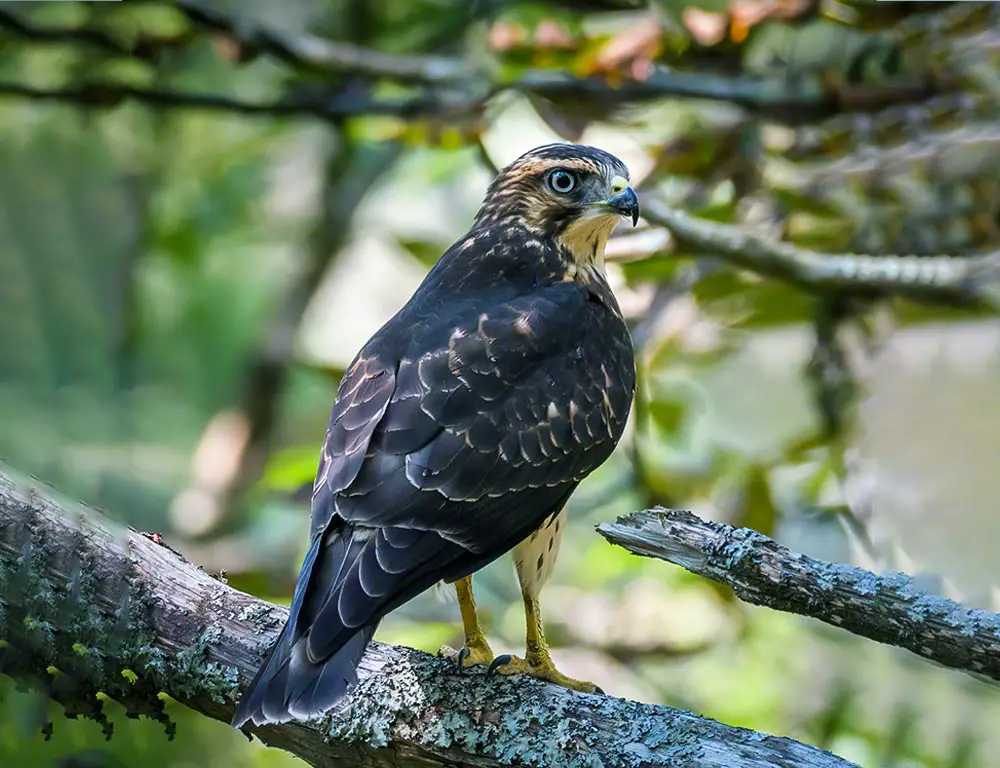
The Broad-Winged Hawk is a relatively small hawk, known for its stout body and broad wings. Adults have a rufous barred belly and a distinctive white tail band.
Found in forests and woodlands across North America, they are most famous for their spectacular migrations, forming large groups called “kettles.”
These hawks feed mainly on small mammals, amphibians, and insects. Their call is a piercing whistle, heard most frequently during the breeding season.
Broad-winged hawks nest in trees and are more often heard than seen, due to their preference for dense woodland habitats.
| Kingdom | Animalia |
| Phylum | Chordata |
| Clade | Dinosauria |
| Class | Aves |
| Order | Accipitriformes |
| Family | Accipitridae |
| Genus | Buteo |
| Species | B. platypterus |
42. Red-Headed Woodpecker (Melanerpes erythrocephalus)
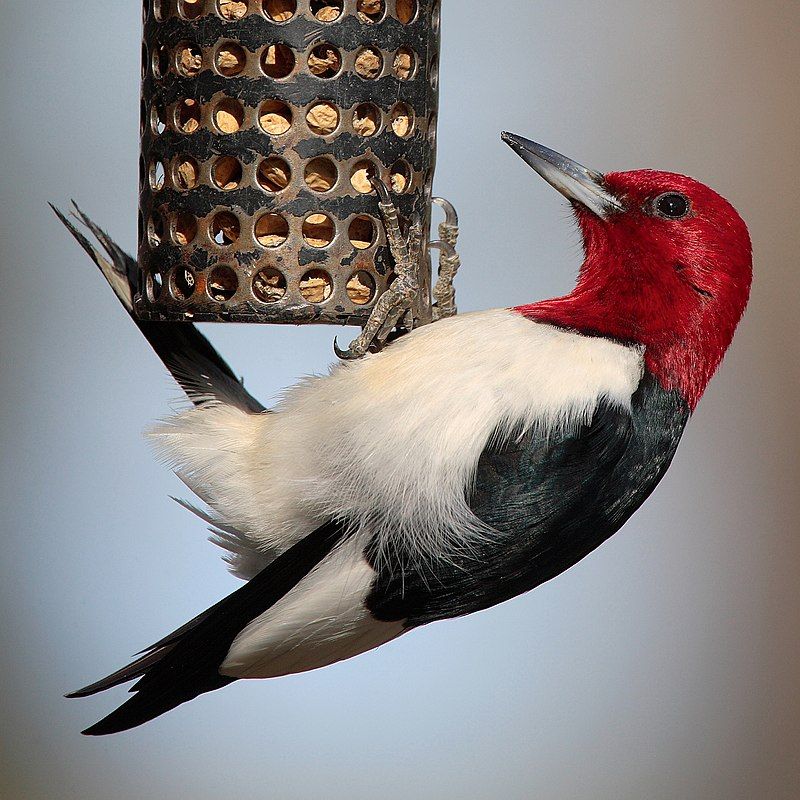
The Red-Headed Woodpecker is a striking bird with a bright red head, neck, and throat, contrasting sharply with its black back and white underparts.
They are found in open woodlands, groves, and farms across the eastern and central United States.
These woodpeckers are omnivorous, eating insects, fruits, nuts, and occasionally small rodents or bird eggs.
They are known for their behavior of storing food in tree crevices. The Red-Headed Woodpecker is a bold species, often seen flying out to catch insects in the air.
| Kingdom | Animalia |
| Phylum | Chordata |
| Clade | Dinosauria |
| Class | Aves |
| Order | Piciformes |
| Family | Picidae |
| Genus | Melanerpes |
| Species | M. erythrocephalus |
43. Cooper’s Hawk (Accipiter cooperii)
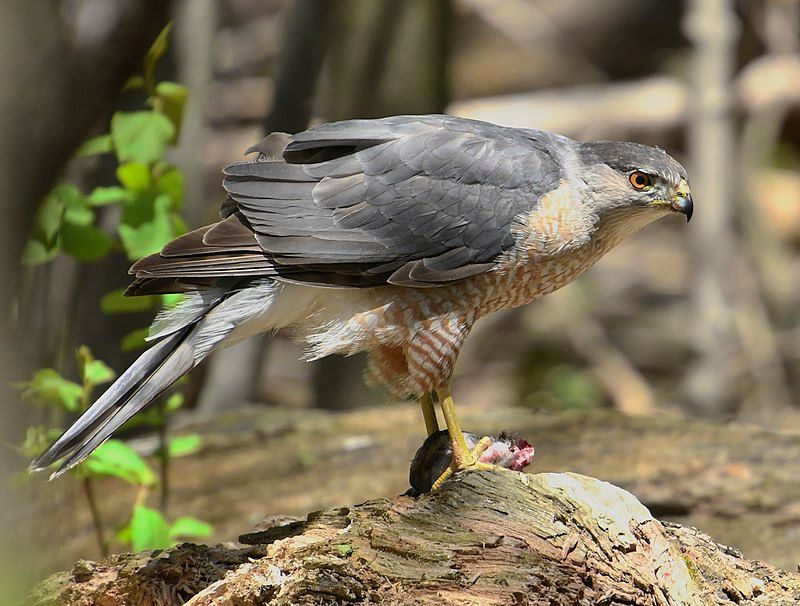
Cooper’s Hawk is a medium-sized hawk, adept at navigating through dense foliage with its short, rounded wings and long tail. They have a blue-gray back and a barred red-orange chest.
These hawks are found in wooded habitats across North America. Cooper’s Hawks primarily feed on birds and small mammals, capturing them with sudden, swift flights from a hidden perch.
They are known for their high-pitched call and acrobatic flights during courtship. Cooper’s Hawks have adapted well to urban and suburban environments, where bird feeders provide a steady source of prey.
| Kingdom | Animalia |
| Phylum | Chordata |
| Clade | Dinosauria |
| Class | Aves |
| Order | Accipitriformes |
| Family | Accipitridae |
| Genus | Accipiter |
| Species | A. cooperii |
44. White-Throated Sparrow (Zonotrichia albicollis)
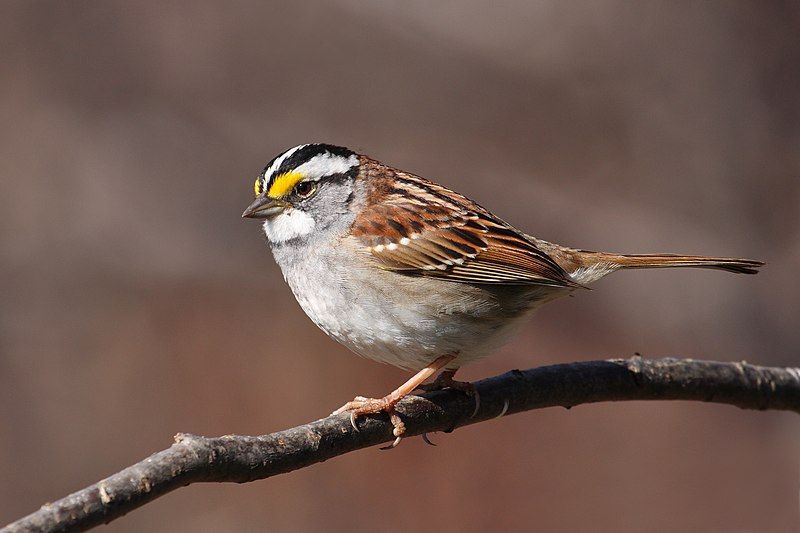
The White-Throated Sparrow is a medium-sized sparrow with distinctive markings: a white throat, yellow spots between the eyes and bill, and black-and-white stripes on the head.
They breed in forests of Canada and the northeastern United States and winter in the eastern and southern United States. These sparrows forage on the ground for seeds and insects.
They are known for their beautiful, melancholic song, often described as “Oh-sweet-canada-canada-canada.” White-Throated Sparrows are a common sight at bird feeders during the winter months.
| Kingdom | Animalia |
| Phylum | Chordata |
| Clade | Dinosauria |
| Class | Aves |
| Order | Passeriformes |
| Family | Passerellidae |
| Genus | Zonotrichia |
| Species | Z. albicollis |
45. Song Sparrow (Melospiza melodia)
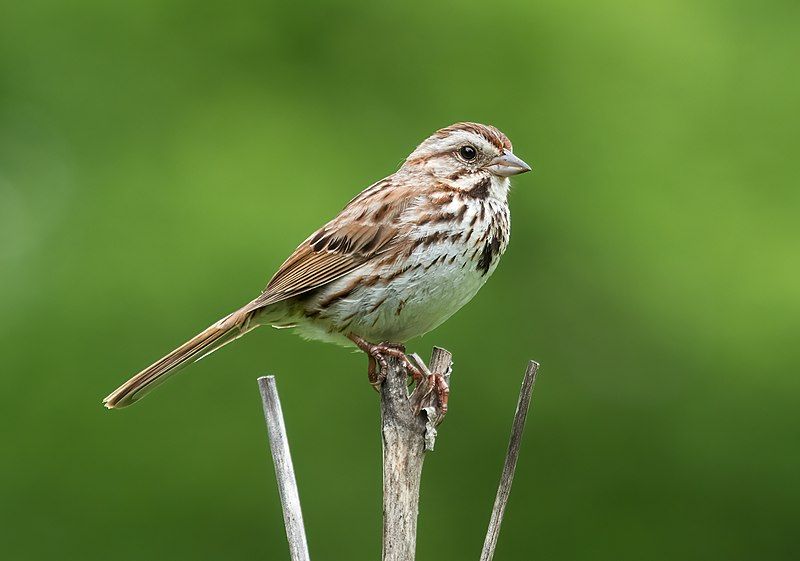
| Kingdom | Animalia |
| Phylum | Chordata |
| Clade | Dinosauria |
| Class | Aves |
| Order | Passeriformes |
| Family | Passerellidae |
| Genus | Melospiza |
| Species | M. melodia |
46. Cedar Waxwing (Bombycilla cedrorum)
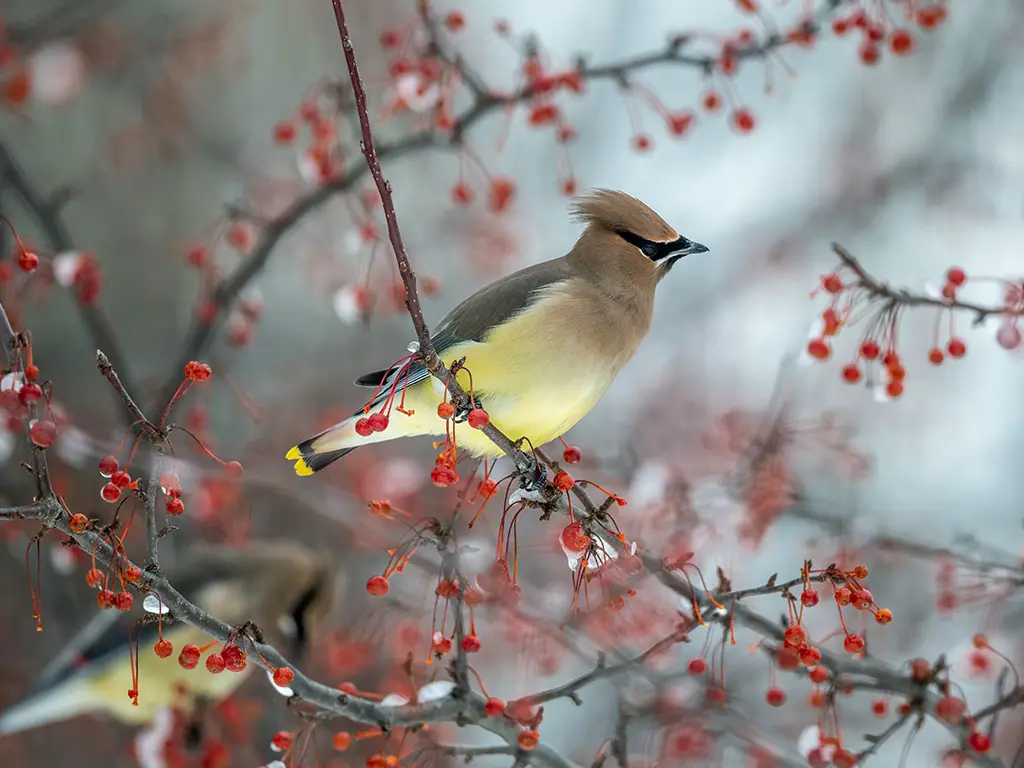
The Cedar Waxwing is a sleek, medium-sized bird known for its polished plumage. It has a distinctive crest on its head, a black mask lined with white on its face, and a predominantly brown body that fades to gray.
One of its most notable features is the bright yellow tip on its tail and the red, wax-like tips on its wing feathers. Cedar Waxwings are highly social birds, often seen in large flocks in forests, gardens, and orchards.
They primarily feed on fruits and berries, and their diet leads them to play a significant role in seed dispersal for many fruit-bearing plants. In addition to fruits, they occasionally catch insects mid-flight.
Cedar Waxwings are known for their high-pitched calls and are also notable for their unique courtship behaviors, which include passing fruit or flower petals back and forth between partners.
| Kingdom | Animalia |
| Phylum | Chordata |
| Clade | Dinosauria |
| Class | Aves |
| Order | Passeriformes |
| Family | Bombycillidae |
| Genus | Bombycilla |
| Species | B. cedrorum |
47. White-Breasted Nuthatch (Sitta carolinensis)
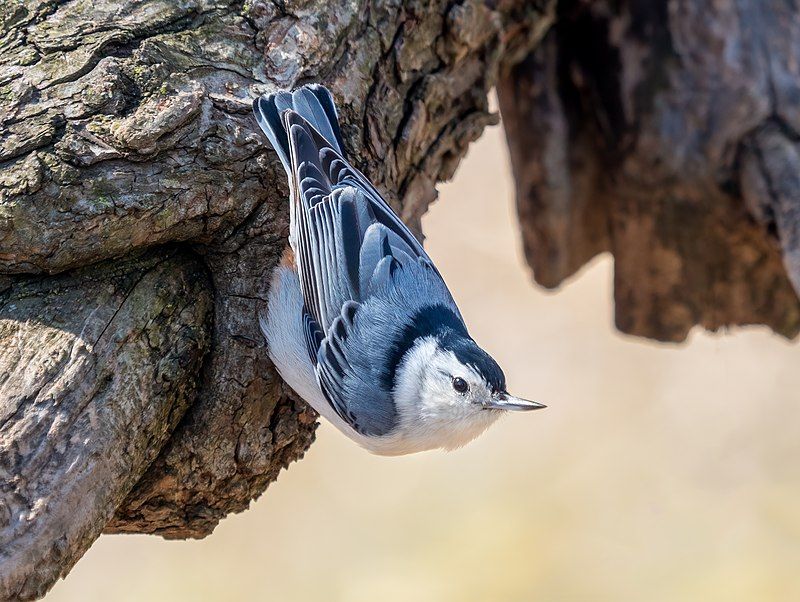
| Kingdom | Animalia |
| Phylum | Chordata |
| Clade | Dinosauria |
| Class | Aves |
| Order | Passeriformes |
| Family | Sittidae |
| Genus | Sitta |
| Species | S. carolinensis |
Conclusion
Winter birds play a vital role in the ecosystem of Oklahoma. They not only bring a splash of color and beauty to the usually gray and bleak winter landscape, but they also provide important ecological services such as pest control and seed dispersal.
The state’s diverse habitat and mild winters make it an attractive destination for a wide variety of migratory birds. While some species are year-round residents, others travel thousands of miles from their breeding grounds to spend the winter in Oklahoma.
Conservation efforts and the provision of suitable habitats are essential to ensure the survival and well-being of these winter birds.
By appreciating and protecting these remarkable creatures, we can continue to enjoy their presence and reap the benefits they bring to our environment.
Overall, the presence of winter birds enhances the biodiversity and enriches the natural environment of Oklahoma during the colder months.